#and also if i can be bothered to make this more of an RPG system or purely choice based!!!!
Explore tagged Tumblr posts
Text
guide to team asano games!
this is a spoiler-free quick look at all* games produced by tomoya asano from 2012 onwards. all games on this list have voice acting in both japanese and english.
*not including mobile games, which includes various daylife despite it now being on consoles because i don't have enough experience with the game to speak on it.

genre: fantasy, adventure gameplay: turn-based rpg platforms: 3DS (original) and switch 2 (HD remaster)
the one that started it all! bravely default: flying fairy is a turn-based rpg with a rich story that uses unique battle mechanics: "brave" and "default" which allow you to use or accumulate BP to do multiple actions in one turn. it also features 24 "asterisks" or jobs that any of your characters can use for a huge mix of potential strategies
in terms of story, you follow the 4 main characters - tiz, agnes, edea and ringabel - throughout their journey around luxendarc to free the four crystals that will return light to the world.
with character designs by akihiko yoshida (final fantasy xii, xiv, nier series) and soundtrack by revo (sound/linked horizon of attack on titan opening fame), the game combines 3d sprites with beautiful 2d painted backgrounds, with an incredible soundtrack to accompany it.
why you should play it: if you're a fan of the classic turn-based rpg style, i highly recommend BDFF! it's an engaging story and the interactions between the main team is a lot of fun. the asterisk system and being able to adjust difficulty/encounter rates makes for a highly tailorable experience. why you might not like it: it's quite a long and difficult game, and can feel grueling at times. some story/character moments did not age very well and the series has famously had some parts censored overseas.

genre: fantasy, adventure gameplay: turn-based rpg platforms: 3DS
bravely second: end layer is the direct sequel to BDFF, with returning characters and the same region of luxendarc with new regions to explore. the gameplay is also the same with 30 asterisks in total, many of them returning from BDFF but with 12 new asterisks included. BSEL also adds chained battles, which are consecutive encounters that grant you boosted exp and rewards.
the story takes place 3 years after the end of BDFF, with new protagonists yew and magnolia joined by tiz and edea from the previous game. yew journeys to rescue agnes from the clutches of the glanz empire, a mysterious new force with a floating stronghold.
akihiko yoshida returns as character designer but the soundtrack this time is handled by ryo (supercell, composer of the one and only "world is mine" ft. hatsune miku).
why you should play it: it's more of BDFF, both in terms of gameplay and story! the new asterisks are a lot of fun and if you care about story continuity, you'd definitely want to play this one after BDFF. seeing returning characters in their new roles is really fun to see! why you might not like it: BSEL is more divisive in the community largely because of the story, which is somehow both goofier and darker at different parts. if you're a gameplay-first type of person this might not bother you, but note that the writing and music are often seen to be inferior to BDFF's.

genre: fantasy, adventure gameplay: turn-based rpg platforms: switch, steam, xbox one, PS4/5
octopath traveler is team asano's new take on the turn-based rpg genre, with BP returning as a similar but revamped mechanic compared to the bravely series. battles are focused around exploiting your enemy's weakness and "breaking" them to do massive damage. with 8 protagonists and 12 jobs in total, OT follows its predecessor in strategic possibilities with job combinations. each character also has unique "path actions", special ways to interact with every npc in the game.
OT has 8 protagonists with separate stories, which you are able to pick and choose when to progress as you wish. all of the travelers journey in pursuit of a goal - ranging from an adventure to find treasure to a lifelong pursuit of revenge throughout the land of orsterra.
character design and artwork is by naoki ikushima and soundtrack by yasunori nishiki, with both being most prominently known for their work on team asano's games. OT was also the first game to feature HD-2D graphics, a combination of classic pixel sprites and modern technologies to create an immersive experience.
why you should play it: again, i think fans of the turn-based genre would enjoy trying this game out! the boost and break system makes for exciting battles with an amazing soundtrack to accompany it. the different stories make for a varied experience, with the format allowing for a wider pool of character archetypes to have a story to call their own. why you might not like it: OT is sometimes criticized for lacking the character interactions between the protagonists that often form the heart of many other rpgs - while the travelers do interact, these are uncommon and have no bearing on the story. if you're someone who really values that kind of character interaction, you may find yourself underwhelmed by OT.

genre: fantasy, adventure gameplay: turn-based rpg platforms: switch and steam
bravely default II is the next installment in the bravely series, with an all-new cast and region and a familiar battle system. BDII's gameplay also focuses on the "brave" and "default" mechanics and 24 asterisks in total, with chained battles also making a comeback from BSEL. the protagonists all have the same base stats this time, allowing for even more flexibility. while the game is still turn-based, it now features an active time battle (ATB)-like gauge that determines when characters make their move.
taking place in the new land of excillant, gloria, a princess from the now-destroyed kingdom of musa, must journey with her companions seth, adelle and elvis to recover the four crystals of light that were stolen from her homeland.
naoki ikushima (octopath traveler) takes over the character designs while revo (bravely default) returns to do the soundtrack, with the new battle arrangements being a real standout. the graphics follow in BDFF's footsteps with 3d models in a 2d painted world - BDII also features an interactable overworld where you can encounter monsters and find items.
why you should play it: if you enjoy the battle system of BDFF and BSEL, this is a newly refined and polished version of it! battles are challenging but lots of fun and revo absolutely outdid himself with the ost. it features a touching story with similar twists and turns that made BDFF so memorable. if you've never played the 3DS bravely games, i think this is a great way to try out the series since this one is standalone! why you might not like it: bravely fans might not be happy with the fact that this is an entirely new entry with no connection to the existing world and lore. other than the lack of continuity the same drawbacks from BDFF apply, with the game sometimes feeling grueling at times - this is heightened by many the new counter ability that many new bosses have.

genre: fantasy, political gameplay: tactical rpg platforms: switch and steam
triangle strategy is team asano's first take on a tactical rpg, with HD-2D graphics returning in isometric form for an entirely different strategic gameplay. the game has you take charge of an army of 8 characters with 22 additional recruitable ones, and the gameplay has an emphasis on height and terrain conditions to spice up battles.
TRST follows serenoa of house wolffort in his quest to bring peace back to norzelia amongst the three warring nations. he is joined by his friend and the crown prince of glenbrook, roland, his fiancee frederica and the house wolffort strategist benedict. the player's choices can greatly impact the story as you test your sense of morality, liberty and utility to see the war through.
naoki ikushima returns to do the character designs (with in-game illustrations by tatsuaki urushihara) while the ost is composed by akira senju (fullmetal alchemist: brotherhood) for a more moody, dark overtone in the game.
why you should play it: fans of the tactical genre will find this a fun challenge! there are plenty of difficulty options to suit your preferences (even a "very easy" mode). the story structure made it one of the most immersive games i've played, with each choice feeling heavier as the game continues. why you might not like it: if you're someone who cares primarily about gameplay in srpgs, you might be put off by the amount of dialogue and cutscenes in the game between battles. each chapter has one battle and each route has up to 21 chapters, with story segments before and after every battle and additional optional stories focused on certain characters.

genre: fantasy (individual chapter genres include sci-fi, historical, western, martial arts and modern) gameplay: turn-based rpg platforms: super famicom (original) and switch, steam, PS4/5 (remake)
live a live is team asano's first remake in the HD-2D style, starting with takashi tokita's classic 1994 rpg! the game features a unique battle system with turn-based battles taking place on a 7x7 grid. each part of the game also features a couple of unique mechanics, depending on which character you control.
LAL's story is split into 8 parts, each taking place across different time periods and regions. each character has a unique goal and gameplay style, ranging from more battle-heavy chapters to one that is clearable entirely through stealth alone.
LAL's characters were originally designed by 7 different manga artists, the most prominent being gosho aoyama (detective conan) who designed the "twilight of edo japan" characters. composed by the legendary yoko shimomura (kingdom hearts, xenoblade, mario & luigi) who also returned for the remake, the new illustrations are done by naoki ikushima.
why you should play it: it's a fun twist on the turn-based rpg format, and the various chapters with different protagonists and vibes keeps the game new and exciting. it also features a story with some very interesting ideas, which all comes together at the end. why you might not like it: similarly to OT, both the gameplay and story can feel disjointed since each chapter is kept short and simple. being a classic game, it's also fairly short, with even a completionist run being shorter than any other game on this list.

genre: fantasy, adventure gameplay: turn-based rpg platforms: switch, steam, xbox one/series, PS4/5
the second installment in the octopath series, octopath traveler II is a new take on the original formula, with new characters and stories. the same battle system from OT returns with revamped jobs and 4 new "advanced" jobs in addition to the main 8. protagonists also have unique "latent power" abilities and an extra path action that can only be used during the nighttime to add extra flexibility and teambuilding possibilities.
OT2 follows the same story structure as the first game, with 8 individual stories but now features additional stories with certain travelers paired together as well as a dedicated epilogue. the range of stories is similar to OT, but characters are no longer stuck in a 4-chapter structure to better suit their journeys.
naoki ikushima (character design) and yasunori nishiki (composer) return for OT2, with the soundtrack now boasting additional nighttime versions of all overworld and town themes. the HD-2D style has also been improved to allow for more camera angles and animations.
why you should play it: whether you loved OT or found it a bit underwhelming, you will likely enjoy OT2's refreshing improvement on everything that OT laid the groundwork for, be it gameplay, story or graphics. since OT and OT2 are not connected, this is also a great way to get into the series as it offers a more polished octopath experience. why you might not like it: many of OT's original criticisms still apply to OT2, so if you're someone who's looking for a very close team relationship amongst the main cast then the octopath series isn't exactly the rpg for you. OT2 also has a grander scale than OT, so i have seen people prefer the first game for its more grounded protagonists.

genre: fantasy, adventure gameplay: turn-based rpg platforms: famicom, NES (original) super famicom, GBC, iOS/android, wii, PS4, 3DS, switch (remake) switch, PS5, steam, xbox series (HD-2D remake)
dragon quest III is the latest rpg to be remade in the HD-2D style, with DQ1&2 to follow later in 2025. this game is chronologically the first in the erdrick trilogy, and features classic turn-based gameplay with a few additions in the remake like battle autoplay and a new class.
the story follows the hero, child of the legendary warrior ortega, on their journey to defeat baramos after their father's disappearance and return peace to the world.
DQ3 features work from series veterans yuji horii (creator, designer), akira toriyama (character design) and koichi sugiyama (composer), who have been with the series since its inception. the HD-2D remake had its cover illustrated by naoki ikushima.
why you should play it: dragon quest is a series that has solidified many jrpg staples throughout the years, and the HD-2D remake is a great way to experience it yourself, with or without previous experience with the franchise. the world is charming and has plenty of content to keep you interested. why you might not like it: many of its aspects naturally feel a bit outdated if you're not someone who's used to older games, with its simpler story structure and UI/system that can sometimes feel clunky. while the story is a highlight of the game, characters in your team don't have personalities or interactions like many other rpgs, so that may be off-putting if you are a character-first type of gamer.
that's all for now! i tried to keep it brief but i don't think that worked very well (lol) i may add to this list as more games are released!
also this may be fairly obvious but most of the criticisms i mentioned are not my own, i just wanted to mention them since many of them do have a very vocal minority who have issues with the games.
i'm not a very gameplay-first type of gamer so i can't help too much on that front but feel free to ask me about any questions you have about these games!
#the ones on steam are 50%+ off until 13 may!! and some are on sale on other platforms until early may as well#i wrote things vaguely enough that i don't think i made any mistakes but please let me know if i did...#i wrote this instead of working all day#satsusays#octopath traveler#octopath traveler 2#bravely default#bravely second#bravely default 2#triangle strategy#live a live#dragon quest 3
128 notes
·
View notes
Text
DAV is maximized (made for?) Tank/Warrior players
Curiosity is absolutely one of my fatal flaws. I was sorta feeling shitty about the whole 'you probably just suck at the fighting system in DAV' thing.
Let me preface this with saying that I'm good with rogues. It's my usual playstyle and I almost always do a first run of any RPG as a rogue.
What I'm really not all that good at? Tanks. Pretty much any other class I'm at least suitably competent with. I mean, I can tank, but it's just not something I'm more than acceptably good at. I also have very little experience with them. I think I've tanked in 3 games? Out of the, it must be hundreds, of games I've played? I just don't prefer to tank. I'm a rogue/mage/healer style player. The one who backs up the tank or keeps them on their feet, y'know?
So, because curiosity will likely be the death of me at some point, and despite never wanting to touch it again, I made a warrior character in DAV. I just... had to know if it was me or the game. I suppose I enjoy actually being a good gamer more than I suspected. DAV offended my pride, perhaps. Self-awareness isn't comfortable.
That fighting system, that I had so much trouble with as a rogue (with other rogues and a mage as backup since we don't get our tank companions til later in act one) has, so far, been so fucking easy as a warrior I'm actually thinking of increasing the difficulty level.
DAV is just maximized for warrior players and people who like to bash barrels in, not any other class. Which is just shitty game design.
I suppose I should have seen it before. The rest of the companions you start with are all support characters. Two rogues and a mage. Your first companion you aquire is Bellara, also a rogue. Oops. Mage. Bellara is a mage. I forgor.
I dunno, I'm going to run this character until I get to the spot (when Harding receives her special ability) where I first wanted to rage quit as a rogue. But so far? I haven't died once. I'd gotten creamed numerous times as a rogue character by this spot in the game. I can go toe to fucking toe with a fucking ogre! And only have to heal once!
It's truly ridiculous. I'll test out mage after, if I can find the patience. It's reasonably unlikely that I'll actually decide to finish this run. Unless I do it for writing my fix it fic reasons . But I can kinda see more clearly why some people actually liked it. It's actually almost fun as a tank.
I did also say I'd never touch DAV again too, though, soooooo.
If you turn your brain completely off, don't give a shit about the Lore, and if the story is a back seat sort of thing for you as a gamer, this might actually be somewhat fun. It's not Dragon Age regardless, they screwed the pooch to sell the pups on that one. (I'm a Lore fiend, story and character first player. I legitimately don't give a shit about the fighting in RPGs. It's a back seat thing for me. As long as I can make it work, I'm good.)
SMDH
I said DAV was wickedly unbalanced in my review series, but I didn’t think it was so bad that they... just didn't bother to make it a fun game for rogue players. Despite them getting rid of half of what makes playing a rogue fun (sneaking, hiding in shadows, picking fucking locks, y'know, rogue stuff.) Not sure about mages yet. I do want to try one just out of pissed off, irritated curiosity, though.
Snorts. They made this game for warrior players. And I can't honestly find words to describe how shitty that is. It lacks most of the stuff that makes any RPG an actual RPG. It's maximized for warriors and people who like to destroy barrels. (Why. Why the fucking barrels?) Rogues are nothing but light skirmishers. I'll have to actually play a mage and see, but I've talked to people who said it's easy as a mage, too.
WTAF does BioWare have against rogue players to nerf the class so badly?
I'm honestly floored by how easy this game is as a warrior. I'll even test it out on max difficulty, (which is usually what I play at, max or one down).
But the shittiness of designing a game mostly for tank players can't be ignored. I changed nothing but the class. And I'm not far enough into the game yet for build to matter that much. I think I've gotten roughly 5 skill points to put into my character.
No wonder they denied game keys to honest reviewers.
#bioware critical#DATV critical#DAV critical#Dragon Age Veilguard Critical#Veilguard Critical#Game design#Bad Game Design#who the fuck thinks it a good idea to make an action RPG where it's only fun for warriors?#RPGs are supposed to be fun for every type of class player#I wasn't happy with DAV to start with and I'm even more pissed now#Not every gamer likes playing hack and slash especially in RPGs#Ugghhhhh this game is so badly designed it tempts me to use ableist language
37 notes
·
View notes
Text
I'm having so much fun replaying MSQ on Merlwaen, both because it's fun to experience the story from a different character perspective (I am a chronic replayer of all my favorite RPGs for exactly this reason) but also because it's so good to replay now that I remember why certain characters will be important later. So much of Ariane's playthrough of ARR is just a blurry mess to me now; by Stormblood I could not have told you who Wilred was or why we first met him, and I had definitely forgotten that we met Meffrid all the way back in ARR.
I had no memory of the fact that new arrivals to the Twelveswood have to go to Quarrymill and present themselves to the Hearers there and find out whether the elementals will judge them worthy to stay (something I may be incorporating into Ariane's backstory). And in particularly, that there's an MSQ quest where the Warrior of Light explicitly goes against the will of the elementals (as stated by the Quarrymill Hearer) in aiding Meffrid's wounded soldier. I don't remember there ever being any consequences for this, which is interesting. I mean, it's easy enough to suppose, from a Watsonian perspective, that the WoL gets a "pass" because the elementals can sense the Blessing of Light upon them and are not fucking with that. But it would have been interesting even to see the Hearer chewing them out for it and be concerned about the effect their actions might have upon the whole settlement if the elementals are displeased. (Also, Buscarron helps with that quest, and it's mentioned that he's known to be welcoming and kind to outsiders regardless of where they're from... so is he going against the will of the elementals as well? He certainly doesn't seem to be suffering for it.)
Realistically, it's probably just another example of the writing dropping the ball on Gridania's worldbuilding. I do wish so dearly that they bothered to dig into the potential for corruption in Gridania's governance. I made a post once comparing Gridania to Ishgard in terms of both being theocracies of sorts and a lot of people jumped down my throat about it because "the elementals are REAL" and like yeah, they are real! So is Halone, as it turns out! That doesn't mean that every person claiming to know and carry out their will is a) infallible, b) actually carrying out their will, or c) even correct as to what their will is.
So much Gridania Discourse I've seen seems to focus on the nature of the elementals themselves, and like, don't get me wrong, that is relevant and interesting--but as a lover of Fantasy Politics I am way more interested in asking what, exactly, is stopping the Seedseer Council from using "the will of the elementals" to expel and suppress people they just don't like? Like regardless of how much we actively witness them doing that, what checks and balances are in place to prevent their doing so. That's what I mean when I criticize Gridania for being similar to a theocracy--the concentration of power to a small and limited group, with the justification that they and only they are worthy, chosen, to wield that power. The elementals being real and vital to the wellbeing of the Shroud does not make the system of governance that people have organized around them any less vulnerable to corruption and abuse. Ul'dah and Limsa both have narratives engaged with questions of power and what it means to hold and maintain that power. I simply wish the game was more interested in engaging those same questions in Gridania.
20 notes
·
View notes
Note
top 5 ttrpgs for beginners
Sorry that this one took me a bit longer to answer than all the other Top 5 asks :p i wanted to explain a bit of my reasoning behind it and this gave me q chance to ramble a bit about something that bothers me lol
So, first of all I want to talk about what TO ME makes something a good beginner RPG.
Ramble:
I've talked a bit in the past about how I have sort of a bone to pick with the way so many people, when asked for recs for beginner TTRPGs, immediately decide to recommend extremely rules-light/minimalist/one-page RPGs (Hacks of Lasers&Feelings in particular seem to be somewhat popular on this front), when IMO these types of RPGs are at their best when played by an experienced group (or at the very least with least one very experienced player/GM who can provide some guidance to the others). I think a lot of ppl seem to have the impression that simpler mechanics inherently make a game more beginner-friendly, and that thus the most beginner-friendly games are inherently gonna be the ones with the simplest mechanics. And while this is true to an extent (a 700-page RPG with tons of complicated mechanics to remember is obviously gonna be inaccessible to beginners), when you consider that mechanics exist to DELEGATE decisions about the fiction away from the players and the GM so that they don't have to manually arbitrate them every time, there is point where less mechanics are gonna make harder for new players because it means there's more thing they're gonna have to find a way to arbitrate on and decide by themselves, and that's a skill that takes time to develop. An experienced group can probably get a ton of mileage out of a system that essentially ammounts to "the GM describes the world. The players describe what their characters do, and the GM describes how the world reacrs. When the outcome of a player action is uncertain, then [simple resolution mechanic]" but a beginner group is gonna be a little lost. Especially if the game, like many of these types of games, includes practically nothing in terms of GM tools. So I think recommending beginner RPGs solely on the base of how simple they are is well-intentioned but misguided.
(Ramble over)
So, some of what, to me, makes something a good beginner RPG is
Rules provide enough support that the group won't have to constantly be figuring out how to adjudicate stuff on the fly, but they're simple and flexible enough that they're easy to remember and learning them doesn't feel like a daunting task like it does with a certain game (*cough cough* D&D)
Relatively short and uni timidating. Maybe between like 20 and 100 pages. Players should be able to read through the rules and mechanics in one sitting.
Plenty of examples of play, often a good example of play is what makes a game's rules really *click* for a new player.
Relatively quick and painless to start running for the first time. Character creation should be quick and snappy, and if possible a short pre-written adventure (hopefully with some room to be expanded into something larger) should be included within the same book and ready to run out of the box. Even if your group doesn't like using prewritten adventures, having a *good* prewritten adventure can be a huge help in understanding how to write/design them.
Solid set of GM tools and resources (if it's a game with a GM, of course)
Optionally, plenty of compatible material to either use or take inspo from.
So, I think my recs would for beginner games would be...
Mausritter
If any of you have EVER heard me talk about RPGs you knew Mausritter was gonna be here TBH. I've repeatedly talked about it being one of my favorite RPGs and also that I consider it pretty much an ideal introduction to the hobby. I think the woodland critter theme is extremely charming and attractive for people of any age, while the slightly darker elements that rear their head from time to time keep it from feeling too childish.
The mechanics are simple and flexible but still provide enough structure that even a new GM will rarely if ever be at a loss about how to resolve a particular action. They're familiar to anyone who's played a dungeon game while still being extremely streamlined. 3 stats with the main action resolution being roll-under tests, no classes, characters are defined mostly by their inventory, all attacks auto hit and initiative is extremely streamlined, which keeps combat quick and dynamic, etc. And the mechanics are pretty short and esy to digest too, the players' section of the rulebook only takes 18 pages, including stuff like inventory tables and examples of play, and the website features a handy one.page rules summary (which also comes with the box set)
It's super easy to get running: character creation takes a couple minutes at most, and it features both a simple adventure and hexcrawl that can be used right out of the box with plenty of interesting directions to expand for further adventures.
Now, Mausritter takes most of its mechanics from Into The Odd, so a lot of its virtues come to it, but I think the few changes it made DO make mausritter most beginner-friendly, such as its inventory system which makes inventory management into a genuine challenge without having it devolve into a slog of tedious book-keeping, and the incorporation of a streamlined version of GloG's magic system, which manages to still be simple and easy without being as loose and freeform as the magic system from a lot of OSR games of similar complexity (which can be initially daunting to new players)
But what REALLY makes mausritter shine IMO is the extremely solid set of GM tools. In just a few pages mausritter manages to provide simple rules, procedures, generators and advice for running faction play, making an engaging hexcrawl, making adventure sites, and generating stuff like treasure hoards, NPCs, an adventure seeds and overal just a ton of useful stuff that takes a huge load off of the shoulders of any beginner GM.
Cairn
Lets say you're into Mausritter mechanically but your players aren't into the whole woodland creature theme and want to play something more traditional. Cairn is also built on Into The Odd's system, and takes inspiration from some of the same sources, so it's very similar mechanically. It does feature some significant differences regarding magic, character advancement, and how injury and healing work, but overall it's still mostly the same system under the hood, so a lot of what I said makes Mausritter a great introduction to the hobby mechanically still applies here (quick and flavorful character creation, dynamic and streamlined but dangerous combat, etc). It's also a classless system that features msotly inventory-defined characters, but aside from the option to randomly roll your gear, the game also offers the option of picking a gear package in case you wanna emulate a particular fantasy archetype.
Now, Cairn is a much more barebones document, and doesn't even feature examples of play or an explicit GM section with resources for running the game, which breaks with the things I said I look for in a beginner RPG. However, in this case I'm willing to forgive this because, first, Cairn's website features a plethora of first party and third party stuff that isn't featured in the book itself, including examples of play, GM procedures and tools, modular rules, and a wealh of conversions of creature stat blocks and adventures from D&D and other fantasy adventure ttrpgs.
And Second, something different that specifically distinguishes Cairn as a good example of a beginner RPG is how it explicitly outlines its philosophical and design principles, and the principles of play for both the GM and the players before it even shows you any rules, which is something that I think more games and ESPECIALLY begginer games should do. IMO the whole book is worth it just for that little section.
Troika!
Troika is a game built on the Fighting Fantasy system (which originally was less of a TTRPG system and more of an engine for a series of choose-your-own-adventure books) with a really interesting pseudo-victorian space opera weird gonzo setting which is a load of fun. It has very simple 2d6 mechanics, with characters having three stats (Stamina, Skill, and Luck), and being mostly defined by their inventory and the special skills from their background. Character creation is quick and snappy. The game gives you 36 weird and extremely creative character backgrounds, but creating a custom background is as easy as coming up with a concept and the names of a couple special skills that support that concept. It also has a very unique initiative system which might be a little divisive but which I DO find fun an interesting.
While it lacks many of the GM tools I praised Mausritter for, it makes up a little bit for it with an initial adventure that does a wonderful job at naturally introducing the weirdness of the setting, and which at the end presents a ton of opportunities to segway into a variety of urban adventures.
Now, a lot of beginners come into RPGs specifically looking for a D&D-type fantasy game (which is a problem because D&D is a pretty bad option for a beginner RPG) so for those types of players I would recommend
The Black Hack
The Black Hack is probably my favorite game for doing D&D-style fantasy roleplaying. It's a game that at its core uses the original 1974 white box edition of D&D for inspiration, but modernizes, reimagines, and streamlines every aspect of it to be one of the most simple yet elegant D&D-like experiences out there. For example, TBH uses the six stat array that all D&D players know and love, and with the same 3-18 point range, but does away with the attribute score / attribute modifier dichotomy, instead building its entire system around the attribute scores, with all rolls in the game being roll-under tests for a relevant attribute (including initiative, attack/defense rolls, and saving throws). It also innovated some extremely elegant mechanics that went on to be very influential for other games, such as its Usage Die mechanic as a way to streamline keeping track of consumable resources. Basically, it's like if D&D actually played the way it looks in cartoons and stuff: character creation doesn't take 3 hours, every combat encounter doesn't take five hours, and you can place some emphasis on resource management without the game making you want to tear your hair out with boring bookkeeping.
And one of the coolest things about it is the way it handles compatibility. Despite taking loose at best mechanical inspiration from D&D and playing very differently from it, TBH is intentionally designed to be compatible with a wealth of old-school D&D material. While it very clearly stands as its own distinct game, it's designed in such a way that you can prety much grab any creature stat block or adventure module written for any pre-3e version of D&D and use it in The Black Hack with little to no effort in conversion required.
The first edition of the game is a pretty barebones 20-page booklet that just describes the basic game mechanics, since it was assumed you'd probably be using D&D creature stat blocks and adventures with it anyway, but the second edition was significantly expanded with a bestiary, expanded GM procedures and advice, and tool for creating anything you could want: Hexcrawls, towns, dungeons, quests, treasure hoards, NPCs, dungeon rooms, traps, secrets doors, etc. plus a short premade adventure and even a few premade unkeyed dungeon maps that you can take and key yourself if you're in a pinch for a map, which as you all know, I think GM tools are an important part of a beginner game.
The game only includes the 4 basic classes from old-school D&D (fighter, thief, cleric, magic user) but the community has made several supplements adding back more modern classes.
Now, if you're that type of player that wants a D&D-like experience and you want an alternative that's still beginner-friendly but doesn't deviate as much from D&D's design, I would suggest:
either Basic Fantasy, or Old-School Essentials (or any good retroclone of Basic D&D tbh)
BF and OSE differ a bit from each other but at their core they're both attempts to repackage a relatively faithful but slightly modernized version of the 1981 Basic/Expert D&D set, retaining mostly the same mechanics while ditching a few of the aspects that might seem counterintuitive to a modern audience (such as descending AC, which I personally don't mind but I udnerstand why a lot of people find it confusing). I'm recommending these bc I think if you're gonna play any actual D&D product, the B/X set represents D&D at its most beginner-friendly (character creation is at its quickest and simplest, combat flows faster and remain itneresting due to doing side initiative rather than individual initative, the mechanics forsurprise, stealth, and dungeon exploration actions such as looking for traps are streamlined to simple D6 rolls) while still being recognizably D&D and these retroclones put in a bit of an extra effort to make them even more accessible to modern audiences.
Now, just like The Black Hack, these retroclones are limited in their race/class choice to the classic old-school D&D human/halfling/elf/dwarf and fighter/cleric/thief/magic user, but in the case of Basic Fantasy, the community has made several race and class supplements, some of which are showcased on the official website, and in the case of OSE, the OSE: Advanced addon reintroduces many of the modern classes and races that were originally introduced in the Advanced D&D line.
Have in mind that this list is pretty limited by my own tastes and experiences. I'm very aware that the very specific type of game I tend to play and like and experiences inroducing some of my friends to the hobby completely color the scope of what I can recommend as a good beginner RPG, and that that scope is significantly limited. I also like more narrative storygame type stuff, and I don't doubt that some of them would also make a fantastic introduction to the hobby (some PbTA stuff like Ironsworn, Dungeon World and Monster of the Week comes to mind) but my experience with them is not significant enough for me to feel confident in telling which of them are good beginner RPGs.
Also note that there are several games that I consider to be more MECHANICALLY beginner-friendly than the ones I listed here, but that I avoided mentioning specifically because they offer extremely little to no support in terms of GM tools, which I think is an important and often overlooked aspect of beginner-friendliness for any game that includes a GM! But they still might be worth checking out. These include games like DURF, FLEE, OZR, A Dungeon Game, Bastards, Dungeon Reavers, Knave 1e, and Tunnel Goons.
199 notes
·
View notes
Note
hey I have been working on a bit of a side project for some time i play a lot of queer indie games where sex and sexuality are prety common themes but i think that some of the best of these involve actual in depth conversations around things like bodily autonomy and address societal issues youd less than likely find outside of the genre i always thought it was odd though how despite the tendency of these indie games to be abl to go beyond some of the confines of larger production quality games so many of those types of games tend to have pretty uniform body representation skinny usually white able bodied etc if theyre trans theyre usually pre/non op so my side project is that for some time now ive been playing around with the idea of making an rpg video game exploring themes of autonomy commodity fetishism and the goal is to create a system wherein the user can create a character from a very wide array of physical traits weight race secondary and primary sexual characteristics and i thought it makes sense to also allow a fair bit of discussion around disability in a game thats so heavily about autonomy and a tendency of people to treat others especially those in minority groups as commodities while the game has ome disabled side characters i also wanted to give the user the option to have their character have mobility aids and or have their character present with physical disabilities this is all very long winded and im sorry but ive been trying to find where i can find more information about certain physical disabiities and how to depict them both visually and textually and how not too and i feel im unfortunately coming up dry in my search for some of this information especially about some physical disabilities/congenital conditions like phocomelia your art is really wonderful and youre one of the few artists ive found on tumblr who depicts such a wide range of physical disabilities if it wouldnt be a bother i would really appreciate any resources or pointers you can provide
Hey! For the writing part I will just recommend @cripplecharacters , check out the tags there, etc. There is also some vis dev advice on there but not as much.
For visual IRL references, positive exposure is pretty good, I use it a lot for my own drawings
If you have a question for drawing a specific disability then feel free to send me an ask/DM me, I will try to help. But I have to preface this with saying that I don't have experience with drawing every disability or every aid so I can't help with every scenario. But if you saw me draw it before I will probably be able to at least give some pointers
[For your second ask, I don't think I'm currently able to provide paid art advice because I just don't have enough free time and I don't enjoy leaving people waiting for months. Donations are very welcome if you feel like sending one, but I'm not in a position do be doing proper commissions right now]
Thank you for the nice words=)
9 notes
·
View notes
Text
Game Pile: Not Disco Elysium
Tiredness.
The ache, the will, the want to just go to sleep, to go to bed early at a sensible time, to not struggle with a schedule, a schedule that no one’s set but yourself.
There is no need to do things this way.
There is no problem with breaking a habit a little bit at a time.
Perhaps you would do more significant things if you slept more.
Spoiler Warning, I don’t intend to present any spoilers for the plot of Disco Elysium. I haven’t finished it. Content Warning, Disco Elysium is a game full of drugs and despair and violence and pseudo-Europeans.
Disco Elysium is a video game. Disco Elysium is a CRPG set in an alternate history, semi-modern detective story, set in a disastrous ruin who is investigating a murder in a city that’s also a disastrous ruin. For those of you who have been looking for someone to explain it as simply as possible, Disco Elysium is a CRPG, a roleplaying game where you have a narrative and a character and stats, and the game uses a resolution system that checks those stats to determine outcomes.
It is one of the most poorly described video games I have ever experienced, and it frustrated me for well over a year before I actually started playing it. Then I waited a year more before I got back into playing it. A whole year of hearing people praise a thing without ever being able to concisely explain why a person should engage with that thing, beyond locking its identity behind barriers of ‘you shouldn’t know what it is without playing it first.’
Here then is a pitch: I would compare it to a text-heavy read-em-up RPG like Baldur’s Gate 2 and Planescape Torment, and I would make those comparisons, because I like it a lot and I like those a lot and the comparison makes me feel good. The characters and stories in those games stand out in my mind, and in Disco Elysium I feel some of the same promise, the same fluttering imagination that hey, at the end of this tunnel there might be something that good. I wouldn’t compare Disco Elysium to something like Fallout: New Vegas (which is good! and I like it!) or Fallout 3 (which I’ve not bothered to re-play for years), despite those being RPGs, where you engage with narrative and characters and stats and use a resolution system that checks those stats for outcomes. Nor would I compare it to Dark Souls 2 (the best Dark Souls), which does all the same things, except maybe it doesn’t really have characters in it (fight me). My other point of comparison, while pointing out games I like, is I Was A Teenage Exocolonist, which is a visual novel.
Skirted around ‘visual novel,’ didn’t you. Visual novel, a genre term for ‘you know, those hentai games that people made really cheaply’ and nobody wants to talk about except when they want to claim it’s been elevated or inverted or given a postmodern makeover. A thing they only talk about to betray their ignorance of the format.
At least you’re confidently ignorant about it. You played I Was A Teenage Exocolonist because it’s got a card game in it.
It’s an armour, right? You tell people what you can’t do and that way they can’t judge you for it. You can even call it ‘rigor.’ Not like you’re doing it because you really wanted to be talking about Libertalia, a game you really shouldn’t have ever bought, because when are you getting it to the table?
It’s a game for nevers.
Idiot.
So you’re talking about Disco Elysium.
But you haven’t finished it.
Much has been made of the value of Disco Elysium as an example of good writing in games and that sets my hairs on the back of my neck up a little bit. Now let me be clear before I go any further, this is not to malign Disco Elysium at all. I really like Disco Elysium. I know because I’ve been playing it now for about 10 hours, I’m on day 2 and I want to keep playing, despite having no idea how to proceed in a way I will find satisying. I’ve twice booted it up for half-hour long sessions of wandering back and forth and trying to work out if there’s anything ahead of me that I want to do, but I do still keep booting it up. It is enticing. It is engaging.
In playing it, I cannot escape the fact that I would want to talk about this game, and talking about this game would involve creating an article about Disco Elysium on Luigi’s own internet, where Disco Elysium is itself an extremely political subject. The game is still in an ongoing undead status thanks to a dispute over copyright and labour and all that stuff is the stuff you don’t solve by looking at the text until your forehead bleeds. It’s a situation that needs an actual reporter to go to a place and talk to people and look at court records. Someone else did that. It’s also entirely unrelated to the text of the game Disco Elysium.
Analysing Disco Elysium as a game, as a text, tends to involve taking this manifold crystal of a game, and turning it around a little at a time, into whatever form you want it to take. Much commentary about Disco Elysium speaks about the way the whole of the body of text builds towards a conclusion or two that can be part of a grand conversation. That is, the way people look at and talk about this game is standing at one end of it, and looking back, like a completed text, and that completion is informed by the speaker’s experience of playing the game, and bathing in the immense scope of it.
Writing about Disco Elysium at all, ever, strikes me as a waste of time. There is no conversation about it, there is merely some wet concrete into which a general community scrawled ‘good game, good writing‘ and now that concrete is set. This is a thing I noted when I wrote about Bloodborne, which is to say some things are so glowingly praised that to talk about them in any way that does not reinforce the glowing praise is seen as illegitimate criticism.
Disco Elysium‘s introduction is interesting. But it is an awful experience to play.
The game’s systems, under the hood, are fundamentally rudimentary, stat vs numbers and the actual complexity is about stacking buffs and debuffs which are from a comprehensive list of curated modifiers. Less ‘rules for how the world works’ but a million invitations to try something because, sure, why not. The game is very unforgiving, it’s very inconvenient, and it does require you to do tons of reading (or spend ages listening to voice acted lines, which is not my favourite way to engage with large amounts of text).
You don’t like that succeeding at checks doesn’t necessarily mean doing a good job or advancing the story.
You don’t like that you can make checks and get good results and all you get as a reward is a new problem where you fucked up.
You think success should mean something and you don’t like that the game doesn’t agree.
You’re mad that save-scumming the gate didn’t mean anything and it was just a waste of your time.
I am personally of the opinion that any work of significant size loses the ability to be described as well-written, not because the writing becomes bad, but because in any corpus large enough it’s not possible for all of it to be at the quality of its best moments. There are always going to be dry pages you leaf through. The loading screens of narrative, things that break up the best bits so you can appreciate them all marinating in your brain soup. Disco Elysium’s moments of shuffling up between rounds are spent scuffling around for bottles or looking for desperate hope that maybe this area you haven’t looked at lately has the significant piece of information you missed to advance the story. It does this to break up the writing, which is a catastrophic encyclopedia of words and concepts and a whole beautiful fractal of media effects where you learn about a world through its Proper Nouns and the way those Proper Nouns ape the proper nouns you know.
Disco Elysium filters its information systems through a broken, collapsed, splay of a man. That person is then asked to reconstruct reality as best they can in a way that lets you, the player, learn about the world. This is an interesting thing to do in a patient, slow, and steady experience, and can be wonderful for discovering a world as a series of things you care about and interest you immediately. In Disco Elysium this avalanche of verbs is like joining a tabletop game midway through (because you are), and that includes the mechanics. It has stats, but they’re not familiar or explained in familiar ways, and there’s a lot of them, and there’s no meaningful way to handle them. I think you’re kind of just meant to respond to the things you find cool and add skill points into them.
It has some problems when that greater nature is predictable, such as the implication that Disco Elysium has given me so far, that it has thought a great deal about all of the ideas it has, and everything about all of them and all the ways they can play out sucks. This is, not to say the game is Doomer, but rather, in my first ten hours of play, I have been left with the distinct impression that the game will be Doomer. The crushing, inevitable feeling of neverending relentless fucking up is interspersed with ways that fucking up can be funny.
In roleplaying games that I enjoy, there’s generally a meaningful set of choices, something interesting to approach the problem. Your class you start with, stat distribution, companions, it doesn’t matter necessarily what it is, but there’s stuff that encourages you to approach problems, then gives you ways to solve those problems, and when those options get cut off, it can feel frustrating. It can feel curtailed and less like you’re making choices as a character and more like you’re just picking off a list.
Early on there’s a lot of that kind of A-or-B. It wants to show you what a fuckup you were, too, which means that there’s this relentless loserdom, which at first I found a fascinating puzzle to solve and it got really boring, really quick. Where there’s no useful way to advance the story but running out a clock, or picking between two obviously bad choices, I find myself flailing around between picking up bottles and trying to find anything else to do. Go do side material, the game says, and I can’t find any of it to do.
It means that I keep coming back to the two obvious plot threads, and assumptions about what I should be doing or how I should be solving my problems, and realising that I can’t. This isn’t a game where you can wake up in the ruins of an old self, discover what a disaster you were, and try to make good. It’s literally not possible; the power structures of the world mean that the person you were yesterday is a person you can’t ever address in the way that I want to, because I’m not really in control of this character in this game.
It means that when the game presents me with the scenario and the characters in it, I am left unable to do the things I like to do in roleplaying games. Games are always throwing you down tunnels, but in this case, I had enough awareness to look at the tunnels and ask myself: Yeah but do I want to pursue either of these options?
It’s kinda a weird feeling of complete arrest.
Just be a disaster! Flail through the game and vomit on your shoes! Run out the timer and let it hold your hand, don’t worry about feeling like you have agency! You don’t, it’s a lie, and you’re beholden to a person you never were! You’re not here to play a game, you’re here to read about a thing that makes you sad because you can’t fix fucking capitalism with a fucking videogame or a videogame review and you’re only writing about it because this is the game you can’t stop yourself from playing in a month that’s meant to be about things you enjoy, and you can’t think of anything else to write about and so that’s why we’re fucking here with a disaster mad that there’s one fucking videogame where he doesn’t get the opportunity to pretend he’s not a fucking disaster!
I want to make it really clear, I’m talking about the first ten hours of this game. I am definitely compelled, I am interested. I love the way the game uses its dialogue choice interface and the genre of it to play with how characters treat you, like they can tell the options you considered because they can read you as a person.
I just don’t think anyone telling me about it was really giving me a good impression of how messy and miserable and unpleasant this interesting game is to play. There’s a comforting amnesia that comes from knowing a game really well, after all. Right now I’m at the stage of the game, looking at this game showing me a failed videogame studio as if to say, ‘wow, isn’t it interesting how hard and interesting it is to make a videogame?’ and trying to not make comparison to screenwriters and chefs.
Man, imagine if I get to the end of this game and I feel like it sucks.
I bet that’ll be a real horrible article to have to write.
Check it out on PRESS.exe to see it with images and links!
13 notes
·
View notes
Text
Ramblings on Suzerain

Dialogue options that certainly don't foreshadow the events of my term.
Suzerain is a political visual novel where you play as the president of a regional power in a Cold War-era alternate world. Put bluntly, there is little else like it out there and what there is is…well, we'll get to that a bit later. The game also has an expansion where you lead a different nation in the region but I don't have it so if you want a verdict on it, you'll have to go somewhere else, sorry.
While the presentation is a bit basic, it gets the job done, mostly when it comes to visuals. Character portraits are all distinct without being distracting, the map is detailed and pleasing to look at, and the text is easily readable(this is especially important, there is a lot of reading.) Music is the same handful of tracks and I found myself getting a bit tired of them fairly quickly, although the "shit is going down" track did end up training me to focus even more on what's going on.
The gameplay itself is, unsurprisingly, very simple. What it lacks in complex systems, however, it more than makes up for in the RPG player's favourite phrase to argue over the meaning of: choice and consequences. You inherit a nation that is at the precipice due to the actions of your predecessors, and it's up to you to fix every last problem. You must deal with problems like recessions, ethnic tensions, foreign relations, constitutional reform, and much more. It's extremely overwhelming, but that's the point. Politics isn't easy, and even seemingly minor choices will come back to haunt you hours down the road.
Despite being overwhelming, a lot of the problems the nation will face will be very familiar. The Cold War of this world is almost identical to our own, and you can choose whether to side with the capitalists, the communists, or just go your own way. All your decisions are tracked on a political compass, and though the names may change, the ideologies are laid out the same. And even when there's something that just isn't clicking, every nation, major character, and organisation has its own codex entry that's just a single click away. The game will occasionally be a bastard and have a decision where the right course of action is something you'd only know from someone's codex entry, so be ready for that.
The writing itself, like the presentation, gets the job done. There were many moments where the prose felt exceedingly dry and only grabbed my attention because of the events that they were describing. This isn't the case 100% of the time and the writers do much better when a scene is mainly focused on character dialogue and conflict, but the rest of the time it feels like the textual equivalent of watching C-SPAN. Despite this, Suzerain is probably one of the best examples I've seen of this niche genre, and it's not even close. While something like The New Order will compensate with things like a wider range of nations to play as, it loses out on many QoL features, has a much narrower range of choices and consequences, and has to deal with the fact that it is a Cold War visual novel messily strapped to a WW2 strategy game.
Overall, I'd recommend Suzerain. It tackles a subject matter that not many games really bother with, and does so with a level of maturity that seems so rare in this medium. While a single playthrough will set you back about 10 hours, there are so many different impactful choices to make that all lead to unique endings. While I must set it away for now, I'm absolutely coming back to it in the future to see how things could've gone differently, whether I finally succeed at building True Communism™ or choose to go down a worse path. I'm just a regional power, it's not like I can end the world.
…right?
15 notes
·
View notes
Text
Ranking the RPG style games I played in 2024:
Just a note, I'm ranking based mostly on my enjoyment, and this ranking is not meant to be an actual statement of their respective quality. I enjoyed every single one of these games regardless of their ranking, and I played through their complete stories and most or all side quests. Also, as you'll see, this was just a stellar year of RPG gaming for me, so really the worst I can say about any of these games is that they're just good.
9. Greedfall
I made the big mistake of playing this right after finishing Baldur's Gate 3. No RPG was going to compare well to that. Greedfall certainly had an interesting world and story, and I liked the diplomatic aspects of it. Greedfall does attempt to have an interesting companion system by letting you grow your relationship with companions and choose one to romance, though it's really quite a shallow relationship you have even compared to other games from around the same time or earlier. The thing that really bothered me most about the game is the repetition. Environments are almost identical everywhere you go, and the combat gets repetitive after a while too. However, if I remember, this game was made by a fairly small studio with limited resources, so it's actually an impressive achievement in that sense.
8. Mass Effect 1
Don't kill me, internet, but ME1 didn't impress me all that much. I think the best thing about it is the thing that really held the series together from game to game: the characters. The companions are mostly great, even in ME1. It introduces some of the most iconic characters of the series like Garrus (my beloved), Wrex, and Liara. The romances always felt a little lacking and awkward to me in this game, but maybe I was just bitter that you couldn't romance Garrus yet. The combat and leveling up system were still not perfected, and exploring the planets often felt kind of clunky and grindy. But overall, it introduced us to one of the most iconic video game protagonists of modern gaming, and it set the base for the rest of the series, so I can't complain too much.
7. Octopath Traveler II
So, I went into this one with no knowledge of the first one. Now, I fully intend to go back and play it. This game had a lot going for it. You get to know the characters so well through their stories, and somehow the huge variety of tones from story to story made it more engaging instead of jarring. Going from really dark and depressing tales to lighthearted and hopeful ones was actually a lot of fun. I loved the way you got to see where each character was on the map and pick which order to meet them in. The art and visuals were gorgeous, the bosses were awesome, the storytelling was effective, and the different abilities of the characters were fun to use. My only real complaint is that the combat did start to feel repetitive after so many hours of gameplay, often fighting similar enemies. Overall, it was one of my favorite games this year, even if it didn't make it to the top of my RPG list.
6. Sea of Stars
I would die for Garl, that's all that needs to be said, right? I technically played over half of this one in 2023. I put it on pause when BG3 came out and only came back to it months later. I'm glad I did. This was really just a beautiful game. The scenery was beautiful, the attacks and ultimates were beautiful, the character models were beautiful. The story was fun in a classic JRPG style. There were certainly dark moments, but it was overall a hopeful game, which I personally appreciate, and there were several times the humor really knocked it out of the park. The characters certainly could have had more depth, but in this style game I didn't genuinely feel like that was a problem. Like many games in this genre, the combat did become repetitive at times. But this game made me do one thing almost no game does. After finishing the main quest it motivated me to get back in there and finish up the few dangling loose ends that I left behind. And boy was it worth it.
5. Mass Effect 3
Even though I didn't play Mass Effect until this year, I've been a gamer all my life, and I remember the outrage around ME3 when it came out. And some of that I understand. The ending left something to be desired, there were plot holes, many things just felt too convienient, and, of course, Kai Leng. Still, in my opinion, this series has always been built on the back of it's characters, and few if any games have let you build such long lasting and meaningful relationships with the companions. I guess I might have been angry if I romanced someone other than Garrus, but getting to build on that relationship (and the friendships) from game to game was amazing. And I can't discount the fact that ME3 contains perhaps the greatest piece of DLC of all time, The Citadel DLC. So in the end, maybe it all balances out.
4. Dragon Age: The Veilguard
I don't care what anybody says, I loved this game. I genuinely liked all the companions, which (unpopular opinion) is more than I can say for some of the previous Dragon Age games. I found the combat really fun, but I always think playing as a mage is a good time. The Spellblade specialization was a great time, and I liked that mages in this game have the option to get up close and personal, which combats one of the biggest issues with mage gameplay in many RPG games. I didn't think the villains were anything to write home about, but the same could be said for Inquisition. I thought the game made interesting additions to the lore of the world as well. I've seen some complaints about voice acting which is just baffling to me because I thought the acting was stellar. And of course, my beloved Emmrich is going right up there with my favorite Dragon Age companions. He was such a well acted, animated, and written character, and he was a great, fresh take on necromancers. It was interesting playing this in the same year as the ME games because honestly it often played like it was an ME game, but I love them, so no complaints about that here.
3. Mass Effect 2
Most people in the RPG community seem to agree that this is an iconic game. I loved the character focused missions, though at first it took some adjusting. I had to realize that the characters WERE much of the plot. This was perhaps the first game I've played where you get to keep more than just 1 or 2 characters from game to game, and it was probably the only game I'd played where you got to carry over a romantic interest from game to game. Playing the ME games right in a row really allowed me to properly experience the improvements in everything from combat to traversal to character arcs. In any other year, this probably could have been my top game.
2. Disco Elysium
I slept on this game for far too long. I'd heard how weird it was, and while I like a little weird I thought it might be too much for me. But it was on sale and I was still in the post BG3 funk. When I started it, I still didn't think I would like it. But I quickly got invested in the mystery and in the fabulous characters of Harry and Kim, and it was over all too soon. I absolutely loved the attribute/skills system in this game. It genuinely felt like some of the best I've seen, and not only was it a cool and story relevant system, but it legitimately affected the way you played the game and reacted to different situations. The voice acting was equally amazing. The art style worked perfectly with the tone and the setting. It was uncanny and absurd, it was timely and serious, it was heartwarming, it was tense, it was devastating, it did everything so well. Even the music was perfect. My only complaint is that I stupidly played this on Switch, and crashing was a huge issue for me throughout the game. Don't repeat my mistake unless you have no other option.
1.Baldur's Gate 3
Little needs to be said about what makes BG3 great. Sometimes less is more. The character interactions and relationships are among the best I've ever experienced, the acting and animations were top notch, the sheer variety of role playing choices and endings were absolutely the best I've experienced, and this is the rare game that I plan on playing more than once.
Honorable Mentions (Games that are only sort of RPGs)
Stray Gods
If you look at the official title of this game, it has "Roleplaying" right in there. Still, I would say this is RPG-lite. You do make decisions that affect your ending, you do interact with characters, and there are even romance options. On the other hand, you don't really have choices in regards to customization or building your protagonist, there's no skill/level up system that I remember, and there really isn't any fredom of exploration or side quests, so in many ways it didn't feel like a full RPG. More than anything it feels like a visual novel (which is not a complaint). It was a great game. I loved the protagonist. The songs were fun, and getting to change the tone and content of the music was an awesome concept.
Thronebreaker: The Witcher Tales
I loved this game. I don't know why I hear so little about it. Much like the other Witcher games, it forces you to make really difficult choices over and over again, often with no real right answer. Meve was a fantastic protagonist, and most of her companions were memorable and interesting. Your choices do ultimately affect the ending and often have basic resource related consequences, but while the actual combat always felt life and death it pretty much never had real consequences. You're often told, "don't fight these guys, we don't have the troops," but you always win and rarely lose troops anyway. Still, it was a great game, and I played for over 60 hours. This one doesn't fully fit into the RPG category for me just because it's primarily a deck builder, but it does have a lot of other RPG traits. It has world exploration, fun companions, and you can level up your army through building your deck. If you haven't played it and you're a Witcher fan, take this as your cue to remedy that.
#baldurs gate 3#Mass effect#disco elysium#Mass effect 2#Mass effect 3#dragon age the veilguard#Greedfall#Stray gods#thronebreaker#sea of stars#octopath traveler 2#video games#Rpgs#Bioware
16 notes
·
View notes
Text
Ever since I got into Dragon Quest, I've sorta preferred it over other similar RPGs like Final Fantasy.
Final Fantasy always wants to have some gimmick, force unrelated mini-games on the player instead of just letting you play, and constantly change up the battle and leveling systems to the point to where the games are barely even similar anymore. For some people, that's a positive. Not everyone wants the same game every time, I get it.
But Dragon Quest sticks to a formula that works, and only really makes changes when something genuinely needs improvement. For that reason, there's not really any bad mainline Dragon Quest games, except for MAYBE 2 depending on whether or not the game's second half bothered you.
Dragon Quest games also just focus on being a fun RPG to play and don't force minigames on you unless it's related to what you were already doing in the main game.
They don't really need gimmicks, they just focus on making the new worlds, characters and storylines of each game really good. The rare times these games actually have gimmicks is always just small stuff like "your wife and kids are your party members" and "explore 2 alternate worlds" or "you can recruit enemy monsters to join you" (and this was before Pokémon).
And this really might just be a me thing, I'm gonna show my bias a little bit, but I like Toriyama's artstyle, how each game can stick more faithfully to a fantasy setting without getting stale, and how the storylines can have an overall wholesome, light-hearted tone while still knowing how and when to bring the feels.
I've always loved RPGs, but ever since I got into Dragon Quest, I just can't put the genre down.
It's really such a shame this series isn't that popular in the west. I think it deserves so much more attention. I'm not gonna lie. I might just be a teeny weeny bit jealous of Final Fantasy's success here in the states… I'm not saying Final Fantasy doesn't deserve it, because it does. I just think Dragon Quest also deserves just as much recognition. I mean c'mon, it basically invented almost every single modern RPG trope and mechanic we know today. Without Dragon Quest, the only people playing RPGs today would be hyper computer geeks. I'm not underplaying any games here, but without Dragon Quest there'd be no Final Fantasy, there'd be no Pokémon, there'd be no Xenoblade, there'd be no Earthbound, and there'd be no Undertale.
Please, I'm begging you, give this series a chance.

#video games#gaming#RPGs#roleplaying games#dragon quest#final fantasy#pokemon#xenoblade#undertale#earthbound
12 notes
·
View notes
Text
Final Fantasy 9 - Review
Final Fantasy IX is considered by many as a love letter to everything Final Fantasy stood for, with a number of callbacks and classic designs, it is also considered one of the best in the franchise and I can see why some people would think that.
I think it's an interesting game and it's worth talking about, so that's what I'll do.

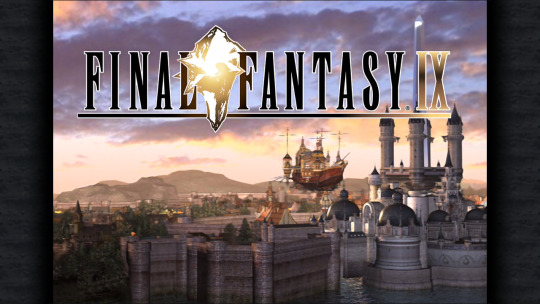
Unlike the past 2 games in the series, Final Fantasy 9 comes back into a more traditional fantasy world.
You follow Zidane, a member of a band of thieves that call themselves the Tantalus Theater Troup, with the facade of throwing a theater show, they plan on kidnapping the Princess of the Alexandria kingdom.

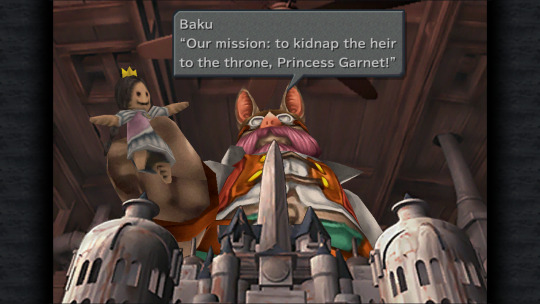
But unbeknownst to them Princess Garnet also wants to be taken away from the castle, as she has noticed some concerning changes in her mother's behavior.
After a very entertaining introduction, they both get away from the castle, along with Steiner, a knight set on taking the princess back, and Vivi, a young black mage who got dragged into the situation against his will.
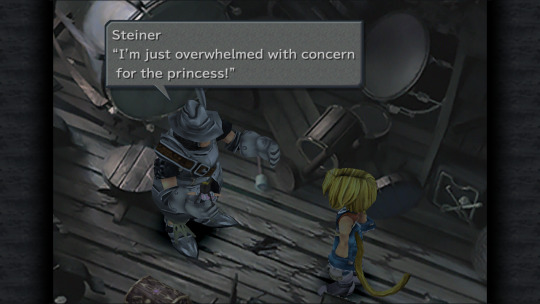
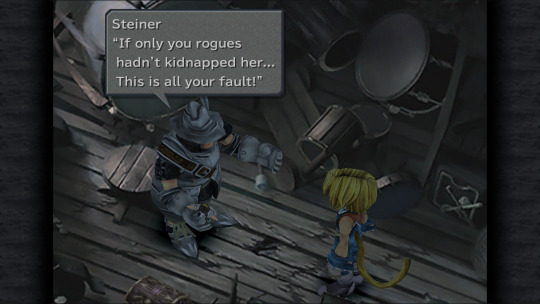
They will discover what is really going on with the queen, and you will see the personal challenges every character has ahead of them. New characters are introduced throughout the game, each with their own conflicts.
In multiple parts of the plot, the characters will get separated, and you will take control of them, but the most important characters are Zidane and Garnet.
Both of them are on a journey that will make them grow up, learn who they truly are, and make hard decisions.
The characters also interact between them quite a lot, which is not something Final Fantasy did a lot of before this point, and I really appreciate that they interact so much.
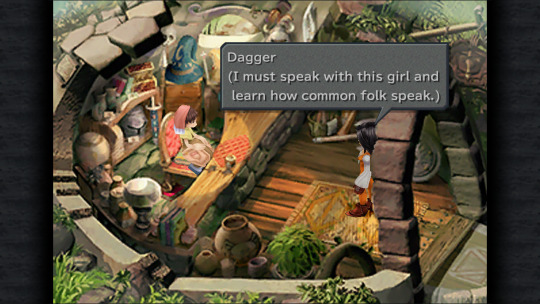
Besides this, every time you reach a new town or village, characters will split up, and you are able to see how everyone interacts with their enviroment, you can clearly see the personalities of each of the main cast and get attached to them.
Though I wish some characters had more dialogue and that some of the optional cutscenes were not so easily missable, it's a huge step forward compared to what they were doing before in characterization.
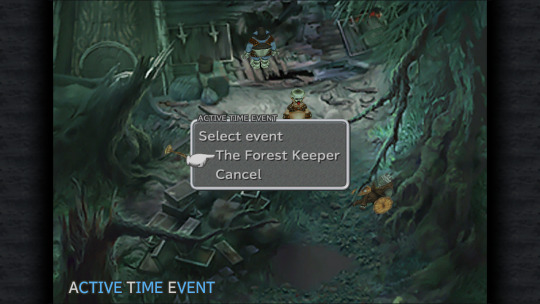
Another thing I like about the plot is that the main villain changes and grows, it might still have a simple motivation that comes down to wanting to destroy everything, but you can believe that the villain has emotions and acts according to them, which is saying a lot when talking about Final Fantasy villains.
So in general, both the plot and the characters are pleasant to see, and I didn't find many things that really bothered me about the writing at all, it's for sure one of the best Final Fantasy plots.
It also has the best Final Fantasy character ever, just look at this little guy.
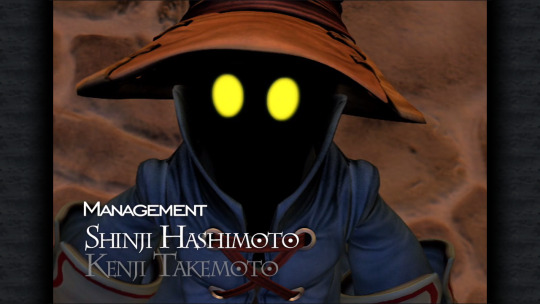
The exploration in this game is also very good, at least in the cities, they are very lively, and with the characters interacting all around a given city it makes every location stand out.
Unlike in so many other RPGs where the cities all look the same, every location has a very distinct style and feeling to it, visiting a new place doesn't get boring.


While the city exploration is good, the dungeons leave a lot to be desired.
They all look nice, but every single dungeon is extremely short, there were several times during my playthrough when I thought a dungeon was looking interesting with the concepts it introduced, and right as I thought it was getting good, the dungeon was over.

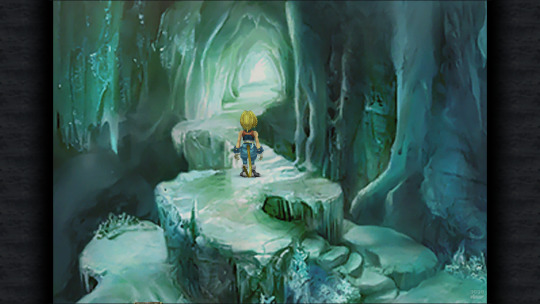
There's a lack of gimmicks and puzzles, and they all feel very linear. I would have loved if dungeons were more intricate, even if that meant they were worse looking.
Now it's time to talk about the gameplay.
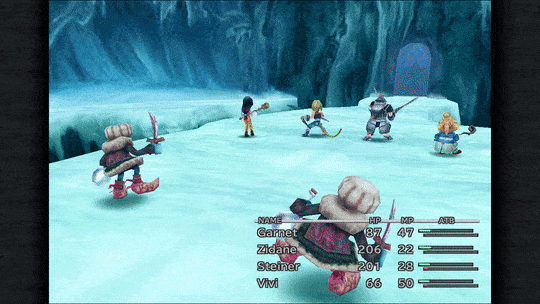
Like it's usual now, ATB makes a return, and it works the same, we are back to 4 player characters and there's a new addition, the trance status, which replaces the limit break system.
When you take and deal damage the trance gauge fills up and when it reaches 100% your character transforms, this gives them new abilities and generally makes them stronger.

Although it is neat, I don't really like that it activates automatically, most of the time it will activate on random encounters where they don't make a significance, and if it activates right before a boss fight it'll take extra time to fill all the way, making trance extremely situational and not something to rely on.
Every other aspect of the fights is more or less the same as it's been for a couple of games now, you wait until your ATB gauge fills up and decide what to do, and like past games magic still works the same, you can decide to use a spell on 1 enemy or on multiple by pressing a button.
What is different is how characters learn skills, which is very unique to this game.
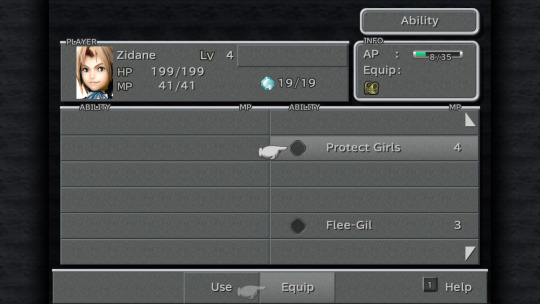
The skills come from equipment, every piece has skills that can be learned, though the character has to be compatible with the skill.
To have the skill you have to actually equip it, and each one has a cost of gems, which you get more of as you level up.
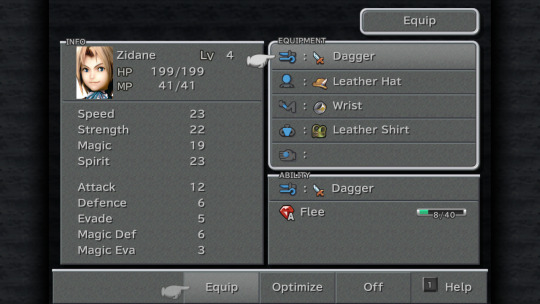
If it ended there it wouldn't be that different from how Materia worked, but what sets it apart is that you can permanently learn any skill.
At the end of every battle you earn AP points, which go into mastering the skills you have equipped, once you master them, they are yours forever.
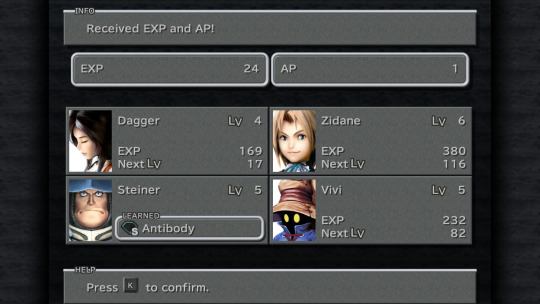
It's a neat system and it allows you to customize your characters however you like while also letting each character be unique in what they can do, which I appreciate.
Another mechanic in the game is the ability to combine equipment in specific stores.
This nets unique equipment with unique skills that are not able to be obtained any other way.

If you happen to have the required ingredients you can get a way stronger armor or weapon than you could get in other ways, with the advantage of learning good skills.
Though I wish some of the equipment wasn't missable, so if you play it try to check every equipment store for stuff you might not have yet, and don't be afraid to buy repeated equipment.
Some of the strongest equipment can be entirely missed, along with some skills, which kinda sucks if you want to get all the skills on all the characters.
While I'm at it I also want to mention that the difficulty in general is very accessible, it's very well balanced, and the superbosses are quite challenging, and even if you decide not to tackle the superbosses, the final boss is quite challenging without being unfair.
In the Playstation 1 version of the game, there's an issue I do have with the gameplay, and that's the battles taking too long.
You might not think it's a gameplay issue but the length of most of the animations messes with the ATB system and how it works.
Some animations are so long that while the animation is playing, every other character filled their ATB gauge already and is waiting for their turn to act, it also messes with how some bosses attack, they have higher speed stat so it's natural they would attack more, but with how the system feels stuck waiting for the animations to play, it more or less feels like they are getting way more turns than they should, it's hard to put into words.
Just for reference, this is how long a fight against a single enemy can be with the default game speed, just as it was on the PlayStation 1.
If this ATB worked like how it worked in older Final Fantasy games, with all the gauges pausing every time an animation played, I wouldn't have any issue with the gameplay, besides feeling battles take too long, which they already do.
This general slowness also discouraged me from willingly starting random encounters when I played the original version, and only really playing through the absolutely necessary encounters.
There's also the introduction to every fight, as if it was the first time you saw the battle arena, it might not seem like much but it takes so much of your time as you progress through the game.
This isn't an issue on new versions since there's is both a speed-up option, a skip battle intro option and an auto-battle option, I replayed the remastered version and it's such a better experience compared to the Playstation 1 version, it's definitely the way to go.
The past six paragraphs or so don't really apply on this version, except maybe only the bit about the ATB not behaving like in olderFinal Fantasy games, but that's a nitpick I have with every single game doesn't behave like that.
Just for comparison, this is how fast the same battle can go in the remaster.

The music is, as usual, very good, with a lot of memorable themes, the graphics are outstanding for a PlayStation 1 game, for the longest time I thought this was a PlayStation 2, the prerendered backgrounds are very good and the models themselves have a lot of detail.
The visual style is also more animated than the previous 2 entries, the designs really stand out and are absolutely memorable.
On top of Vivi being the most handsome guy we also got another peak design in the form of Freya, take a look at her please.

So yeah, in general, this game is great, I do have some grievances with the missable weapons and skills, but that's almost to be expected from a Final Fantasy game at this point, to have missable things, and it's not that much of a problem if you consult some guides for missables.
So don't be afraid to try this Final Fantasy, it is not only one of the best places to start, but it's one of the best Final Fantasy games out there, if you want a good RPG this is definitely a game I would recommend.
#game review#trans creator#long post#rpg#gaming#video games#review#jrpg#square enix#final fantasy#final fantasy 9#final fantasy ix#ff9
4 notes
·
View notes
Text
Leximan launches August 13
From Gematsu

Wordy adventure game Leximan will launch for PC via Steam on August 13 for $14.99, publisher Marvelous and developer Knights of Borria announced.
A “Digital Deluximan Edition” will also be available for $19.99, which includes the base game, the official soundtrack featuring over 100 minutes of music, and the “Basement Breakout” mini tabletop RPG campaign PDF.
Here is an overview of the game, via its Steam page:
About
In a stroke of good fortune, you’ve enrolled in the world’s most exclusive magic school: Academy Elementinia. But on the downside, this is a world in which magic is a bit embarrassing. Still, you’ve got something special. You alone have the ability to use Leximancy, a hitherto unimaginable power driven by something as fascinating as it is enchanting: language. Leximancy is an endlessly fun branch of magic, but it is also a risk of buttock-clenching magnitude. Years ago you caused THINGS to happen, and ever since then you’ve been banished to the school basement with the other failures- I mean learners. Your life as a humble basement-wizard is interrupted as Academy Elementinia is attacked by someone with a baffling agenda and a huge set of fireballs. Don your trusty hat, ready your lexicon, become the outcast that saves the school. Or if you don’t vibe with heroics, at least cause some more THINGS to happen. After all, you’re out of the basement now. Let’s see what you can do.
How to Be Leximan
Be Wordy – Cast Leximancy spells in a unique word-based encounter system, snatching word fragments from thin air to spell out clever incantations.
Be You – Unravel a surprisingly wholesome story about embracing and empowering the real you. I say “surprisingly wholesome”, because there’s also a bit where you kick a trout.
Go Rogue – Use your utter hooligan of a brain to figure out words, puzzles, and a variety of minigames. Summon. Soothe. Enlarge. Enrage. Explode. Have a little sleep. Succeed strangely, or sit back and enjoy your failures. There are hundreds of different ways to play this game, and the best way is your way.
Go Explore – It’s an absolute situation out there. The magical wilds are delirious with magic, the people of the cities hate wizards like you, and there are prisons. Wizard superprisons.
Make Friends? – Bother a chaotic cast of characters, from potion witches and sweaty musclemancers, to a bombastic policewoman and a pyromancer who’s just fed up to be honest.
Get Hats – Give hats to the hat goblins, please and thank you.
Watch a new trailer below.
Release Date Trailer
youtube
9 notes
·
View notes
Text
[Review] The Legend of Korra: A New Era Begins (3DS)

A cromulent companion game.
Platinum's console/PC Korra game was accompanied by a 3DS release. Well I say accompanied; unlike that game, Activision only bothered to release this one in North America. Now I finally have a chance to play it thanks to custom firmware! I know developer Webfoot Technologies best for their Legacy of Goku GBA games, and now here they are with another handheld game based on an animated licence. But how does this tactics RPG stack up against its action sibling?
Despite the new subtitle, this game is built on the same story as the console game. Creepy old guy blocks Korra's bending, the alliance of Triads/Equalists/dark spirits, returning to the Spirit World via the South Pole. But this version has some additional details, like the inclusion of Amon's lieutenant as a miniboss, Korra seeking the advice of spirits in Republic City's spirit wilds only for them to turn dark and attack, or visiting Wan Shi Tong's library for help relearning spiritbending (complete with a boss fight against the big owl himself!) I also enjoyed entering the cosmic universal energy dimension for little puzzle challenges when Korra was regaining her bending powers. In addition to these additions, a big change in how things play out is the extended cast joining her on the adventure, an upside to the shift in genre.
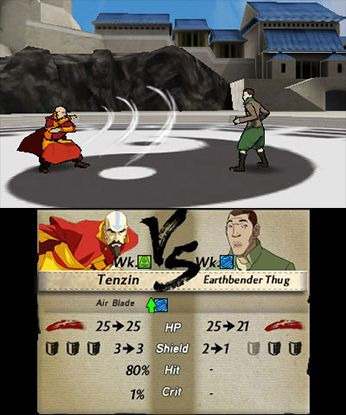
From the start, Bolin and Mako are with Korra, then Tenzin and Kya join in, and finally Lin making for a team of six bending powerhouses. Bumi and, sadly, Asami are still conspicuously absent. But the extra tag-alongs make for actual conversation and more convincing bridging exposition in cutscenes, more appropriate elemental tutelage as Korra relearns her bending styles, and some choice quips. For example, we learn that Bolin named his fists Juji and Roh-tan after Nuktuk's animal sidekicks, and that he has become genre-savvy as a result of his mover career: "when there is fog, something bad happens."
There are understandable presentational drawbacks that offset this. Gone are the full animated sequences, replaced by brief motion comic-style cutscenes. There’s no voice acting either, which is fair enough. And gameplay just cannot look as flashy when you’re just moving sprites around a grid.

To be fair, the sprites look very good. And you get an adorable graphic of Korra riding Oogi on the menu screen. When it comes time to make an attack, the game cuts to a short (and skippable) 3D sequence showing the results, complete with decent little models doing mocapped martial arts moves. The spirits and the main antagonist Hundun can look a bit goofy in these but the mecha tanks are pretty cool if low-detail. The latter in particular have hilariously tiny sprites on the battle map, a stark contrast to their humongous chungus depiction in Platinum’s game.
The tactical gameplay is competent for the most part with decent map designs. The controls and interface can be a bit clunky but they get the job done. There’s a shield mechanic that’s a neat twist, as well as an elemental weakness system that lets you bypass the shields. I liked how each character had their own niche: Mako has many ranged attacks, Lin and Bolin get area effects, Kya can heal, and Tenzin can replenish mana energy points which I had him doing almost every turn once he learned it.

Any attack or even healing and support moves get you experience points which is nice, and every other level-up you get to choose between two skills. These can be new moves or passive bonuses but choose carefully because you can’t change them later! I found myself with a Korra who only knew waterbending for the vast majority of proceedings, and you only get one shot at each other element. Everybody was max level (15) a few stages before the end, but if you’re having trouble with a battle there’s a training stage you can do freely for some extra XP and money (used for buying healing items). You can’t replay completed levels though, even though you get graded on side objectives.
I was pleased by this little tie-in. I’m not a huge expert on tactics RPGs but this one seems good for intermediate gamers like me, not too punishing. There’s some amount of crunchy depth to the elemental system and using each character effectively. And as a Korra fan it’s nice seeing the characters and world rendered in a different style, especially those cute sprites. Not to mention the slight expansions to the storyline. If you’ve got a 3DS, there’s no reason not to head to your local flea market hShop to pick this up!
#the legend of korra#avatar the legend of korra#avatar the last airbender#avatar#webfoot technologies#review#3ds#the legend of korra a new era begins
9 notes
·
View notes
Text
Beyond the WADs’ Roulette - Part 11.1: Heretic Episode 1
The WADs of 2010s are upon us, people. But before we start taking a look at them, there is one game made on a modified Doom Engine, released in 1994… Okay, there are two, and the other one was released in 1995, but we will take a look at that game right tackling an honorably mentioned WAD from 2010 that uses it.
For now, we will be looking at-
#11: Heretic
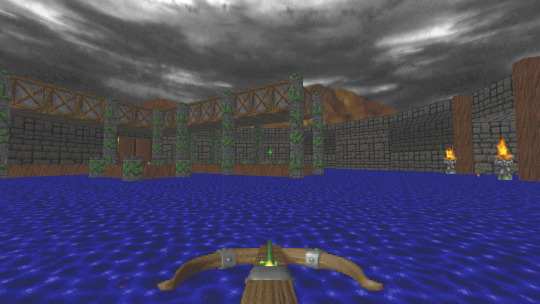
Main author(s): Raven Software
Release date: December 23rd, 1994 (original release)
Version(s) played: Shadow of the Serpent Riders edition
Levels: 27 (three episodes, each with standard 8+1 format)
Heretic is the game made by Raven Software. It is the first installment of the Serpent Riders Trilogy, which includes this game, Hexen and Hecatomb Hexen II. While it wasn’t the first time Raven used the engine from id Software, Heretic is probably the first, commercial game that uses id Tech 1, AKA the Doom Engine.
I don’t really know much about this game’s development. I know that John Romero helped a lot as an executive producer, bringing the guys from Raven computers and even teaching them how to use the engine’s tools. It was supposed to have more RPG elements instead of just an inventory system, but then John Carmack recommended them to basically just make the game like Doom and color it in fantasy paint.
There might be more stuff about the development on the internet if you look at it.
As for the plot, it takes in the land that would be later known as Parthoris in Heretic II. Three mysterious characters known as the Serpent Riders arrived from the east, and they managed to conquer all of its seven kingdoms. One of them, D’Sparil, was left in charge of this land. The elves, known there as the Sidhe, didn’t fall for the riders’ mind control and became primary targets for the youngest of them. The elves were almost completely wiped out.
One of these elves, later known as Corvus, didn’t like that. So he went east to kick D’Sparil’s ass and send him back to science and outter space or whatever.
Now, before I finally start talking about this game (or, to be more precise, its first episode) I would like to mention that I played it on GZDoom (4.13 to be exact) and on the medium skill AKA Bringest Them Oneth.
With that out of the way, let’s begin with the first episode.
Part 1: City of the Damned
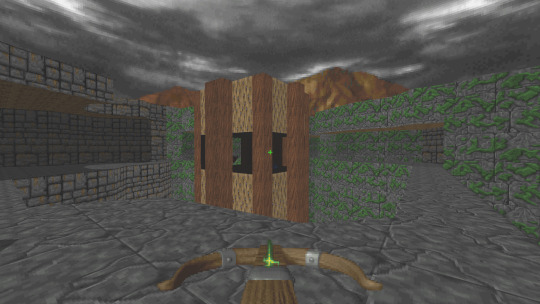
The first episode takes place in the dock city (or at least somewhere that looks like one). While still looking rather abstractional (Heretic is still a game made on Doom Engine), there are moments where it looks better than the ClassicDoom; buildings resemble actual buildings instead of just very tall blocks; there are some additional, non-sprite decorations like church benches, gravestones, tombs, coffins, etc. I also like the textures; they fit greatly for the medieval fantasy theme.
I think the sound effects are good. I can’t recon anything that would be annoying. Some might say that one of the weapons can be ear-grating but I wasn’t that bothered by it.
There are also some ambient noises as you walk by like the church bell, drops, or wind. And I think these were implemented greatly as well. At least they weren’t so loud you couldn’t hear anything else.
I enjoyed the music from this episode. Kevin Schilder did a great job on these tracks. I can’t even decide which music track was the best; I think I’d go with Mist if someone put a gun into my head.
The only problem I have with the music is that over half of the E1 tracks don’t loop properly. Normally, if this was another, amateurish WAD, I would probably blame the WAD’s author for it, but with this game, now that I think about it, I think it might be GZDoom itself that causes this. Now, I played this game the first time years ago so I can’t remember if that also happened with an older version of this source port, but the looping is definitely busted with around five or six tracks in the first episode.
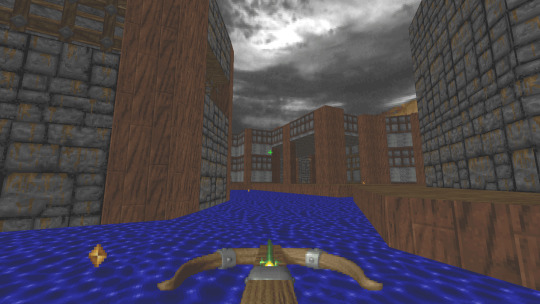
Heretic is a typical Doom clone – kill monsters, find keys and/or switches, and get to the exit. Except, you know, it’s now a medieval fantasy instead of Sci-Fi and shit. I don’t recon the maps from E1 being complicated asides from like one or two (I’ll get to one of them in a minute). And I didn’t feel like they wasted my time.
Now, let’s talk about more noticeable things some of these maps have:
Dungeons has a reference to the blue key trap from Toxin Refinery, where the lights go out and you get ambushed after picking up the same-colored key.

Citadel doesn’t really have anything to explain on its own, but I feel obligated to mention that this map was an inspiration to Devastation from Karma Shwarma; it was basically a similar layout but mixed with Resistance is Futile from Hell Revealed.

Cathedral has two moments where you are forced to look for two slightly misaligned walls to go further. It’s not that obnoxious moon logic now that I think about it (this map is pretty good without counting these), but I still think you might get stuck for a couple of minutes during the blind playthrough.

This is also the map that leads to the secret map – Graveyard. It’s a good map, even with the chessboard floor in the green key area; and even then, that part isn’t that annoying, since around 80% of this floor is optional aside from ammo and health if you need these.

The final map, Hell’s Maw, has an interesting twist, in that after killing the boss enemies, instead of revealing an exit teleporter (or in the case of this map a switch), a monster closet opens up. That might have been the only hard fight in this episode.
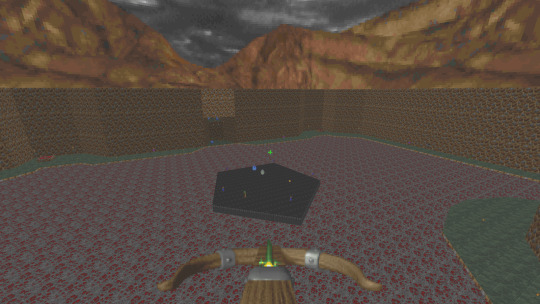
The modified Doom Engine gave this game a couple of new features (no shit). Comparing Vanilla Heretic to Vanilla Doom, you have the ability to look up and down in the former. Heretic also adds floors that can push you even when you don’t move; this feature is kind of janky since it’s more like the entire sector of a map instead of just a floor. So if the sector has water as a floor, and you fly above it (I will get to that later), you will still be pushed even if you are not standing on water.
Also, some of the projectiles can be affected by wind as well. Forgot to mention that.
There are two changes when it comes to keys in this game when compared to Doom. Firstly, visually, instead of a red key, there is a green one, there is only one type of these instead of two, and the keys have rotating sprites. The second change is much more interesting than the first one – the keys follow the pattern. No matter how many keys there are on a map, you will always grab the yellow key first, then the green one, and then finally the blue one. An interesting change but I don’t mind it.
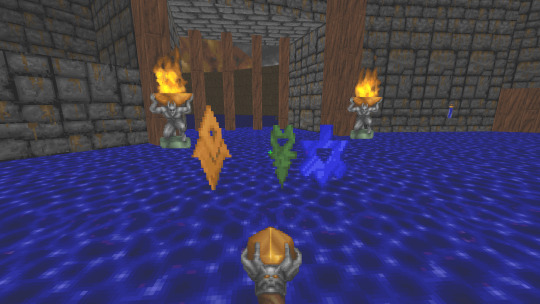
Also, instead of the doors being marked with a specific color, there are special sprites called gizmos to mark which colored door is which if you don’t use the automap.
Oh, and the keys appear on the automap if you play on the easiest skill.
This game also features pods – a variant of Doom’s exploding barrels that can be pushed (which is another feature made for this game). Also, some of them respawn after being blown up (like the ones in Hell’s Maw).
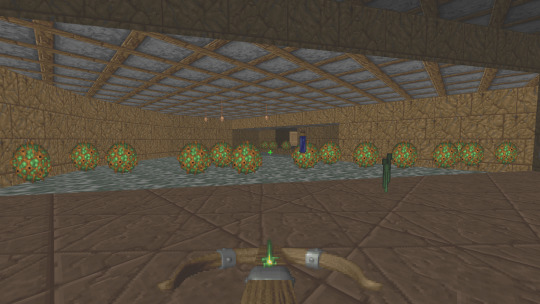
Of course, Heretic wouldn’t be a Doom clone without a bundle of powerups. There are two types of these now – regular ones, and inventory items. Let’s start with the former that appear in this episode.

Silver Shield works as a bridge between the regular Armor and the Megaarmor from Doom; it gives you 100 points of armor like the former but with the latter’s 50% damage protection.
Bag of Holding and Map Scroll are just reskins of Backpack and Computer Map respectively. The former doubles the amount of ammo you can carry while the latter shows the undiscovered areas on the automap.
As for the inventory items, there is no need for a big explanation on how they work – just choose one and press the button that makes you use the item.
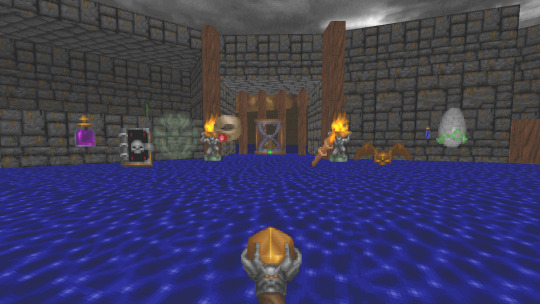
Here are additional things about this system in Heretic – You can carry up to 16 items on a map and moving to another map reduces the amount of items to one per type (except one where nothing is carried to the next map but I will get to that).
And now, to the E1 inventory items:
Quartz Flask is Doom’s medkit that now functions as, you guessed it, an inventory item. It brings back 25 health (up to 100) and it’s automatically used on the easiest skill if you are about to die.
Tome of Power is an interesting item. But I’ll talk about it later when we get to weapons.
Ring of Invincibility doesn’t require an explanation what it does. All I have to add is that instead of seeing everything in white and black, you see everything in orange when the ring is used.
Shadowsphere is Partial Invisibility, yes, but it also turns you into a ghost, making some of the attacks go through you (I’ll get to those later as well).
Time Bomb of the Ancients functions like it sounds – you lay it on the ground and it explodes after a couple of seconds. I guess it’s working on a mob of melee enemies, but I don’t use it that much, so I don’t know.
Torch is a portable Light Amplification Visor. Nothing to add here, although I’ve read that it sometimes flickers when used.
Wings of Wrath will allow you to fly. This is the only item that cannot be carried to the next map if you have at least one of these. I think I’ve read on Wikipedia that flying started as a bug that was turned into a feature (I like when it happens in games).
The final item of E1 is the Morph Ovum. It turns every non-boss monster into chickens that can be easily one-shot. They can still peck you, though.
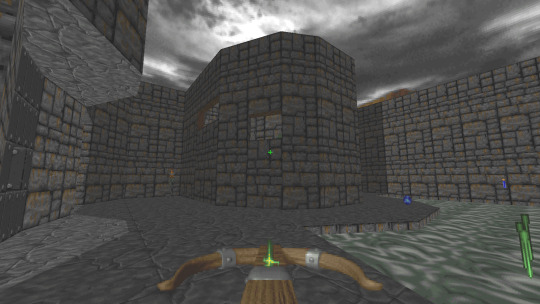
City of the Damned is not a hard episode. Sure, it might be tougher than the original Doom (or at least tougher than the first two episodes of that game), but the advantage Heretic has over that game is that none of the enemies are hitscanners; which means that if you are good at dodging and know which item use when, you might end up with an easier experience than with Doom, even if it feels like there is a lot of more monsters in Heretic, and they feel kind of tanky. Even the final monster closet can be cheesed with one ring and one tome if you have these.
Oh, and by the way, RNG feels less bullshity than in Doom.
There are two types of projectiles you and your enemies throw – physical and magical. The difference between these two is that the former cannot hit ghosts (as I mentioned earlier with the shadowsphere).
As for the enemies you fight, in the first episode, we have five different monsters (counting the boss one), plus a couple of sub-variants; and yes, that includes ghost variants for three of these (two and a half really).

One of the guys above has different attacks. And I’m not talking about being able to throw projectiles along with melee attacks. I’m talking about having two, different projectiles that are not homing and non-homing projectiles for exchange.
I can’t really explain it in words. I think it will be better if you play this game yourself or watch a walkthrough.
Also, like in Doom games, some of the enemies drop items/ammo. Unlike Doom, where it’s only hitscanners (not counting Spiderbitch) that dropped ammo to their used weapons/weapons they were using upon dying, in Heretic, almost all of the monsters in this episode have a CHANCE to drop some ammo, and even a smaller chance to drop an item with two of them.
When it comes to who you fight in the first episode, we start with Gargoyles. They act similarly to lost souls except they can also scratch you when you get close. The fire variant can meanwhile shoot projectiles at you. It would be great if the variants looked more distinctive, though.
Golems are melee monsters, or at least they start off as one (they also look like mummies). Later on, you meet their Nitro variants that can shoot homing projectiles (not as sharp turning as revenants missiles). Both variants can appear as ghosts.
Undead Warriors throw two, green axes at you, and they have a chance to throw a red axe that is 3.5 more powerful than the green one. They also can appear as ghosts, and they always throw red axes.
If you are a Doom WAD enjoyer and played a lot of 2000s WADs, you might remember the void imp that functions similarly to the undead warrior. This is the enemy void imp was based on (although, he is more like a reskin of UW).
D’Sparil has an army of Disciples as well. They fly and flicker when they are about to attack, giving them a chance to dodge physical attacks. Probably the toughest non-boss enemy in the episode.
Finally, we have the boss of the first episode – Iron Lich. These ginormous heads have three attacks – a tornado that can throw you around, a firewall, and an ice ball that splits into smaller shards after hitting something in its path.
The weapons that you get for now in this episode are basically similar to the Doom guns. I’ll get later to which weapon references which Doom gun.

But here is something that you need to know about Heretic’s weapons – these can be powered up. Remember tome of power? That’s what it does when used.
The Staff is a weaker fist. Even when powered up and surrounded by lightning it’s just around 4 times more powerful (up to 81 damage). Compare it to berserk fist that deals up to 200 damage.
The Gauntlets of the Necromancer work like chainsaw – still great against melee enemies (even though golems have a smaller pain chance and attack faster than pinkies). When powered up, the green lightning turns red, its range is longer, and it can suck enemies health.
The Elven Wand shoots slightly faster than the pea shooter, and when powered it turns into a mini-shotgun, firing five hitscan attacks instead of one, and adding two projectiles on both sides.
The Ethereal Crossbow is like a projectile-based shotgun. It fires three bolts – two regular ones and one magical between those. Powered up crossbow shoots faster and adds two magical bolts.
The Dragon Claw functions similarly to a chaingun, but unlike that gun, it uses separate ammo from the elven wand. The powered-up version is where it gets interesting; it acts more like iron lich’s ice attack but with spiky balls (which is ironic since iron liches are partially immune to this attack).

Aside from slightly janky sectors that push you and most of the music not being synced properly, I don’t think I have encountered any bugs. If you are interested in what bugs happen in this game (without using a source port or not), check out Doomwiki or some videos on YouTube.
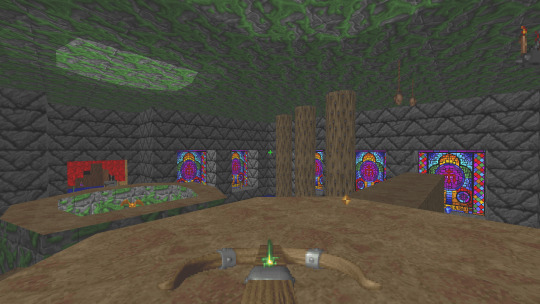
And that’s all I have to say about Heretic’s City of the Damned. It’s a great start for this game (although, you could probably say the same thing about many, other, old school FPSes) and I’m ready for the second episode.
Hopefully, I won’t have that much to talk about like in this part.
#heretic#heretic game#heretic 1#city of the damned#review#part 1#doom wads’ roulette#Beyond the WADs’ Roulette
2 notes
·
View notes
Text
After a few hours into my Dao replay I think I'm starting to really warm up to the gameplay trailer for dav, and indeed its more action oriented combat.
Something I think a lot of us, especially those of us who are a bit apprehensive, are struggling with is that we haven't replayed dragon age in... A while. We have this idea of what it was like but personally my last playthrough was soon after trespasser released. I think we ourselves, unless you're one of the people whose replayed all three games very recently, aren't the best place to decide what dragon age should 'feel' like
Dao is absolutely brilliant and it's combat system is so in depth, the fact that me and a lot of people always complain about how difficult it is just means that it was a system directed towards more strategy oriented people. The little strategy options for the companions, you know the menu not a lot of us use in Dao and da2, where you can tell a companion "if this happens, do that" is a fucking marvel, it's so smart, it's so efficient, it offers so much control it genuinely is amazing. But the thing is that I don't think the core player base of dragon age ended up being the players who used that a ton.
Something you feel a lot especially replaying Dao with modern sensibilities, is sluggishness. You have to remember that it IS a real time action rpg - this means that reactivity is pretty important and even though the other Dao systems make you feel like you're wholly in control, the animations themselves as well as hit boxes and general... Feel of combat doesn't bring that across. It feels like playing an old mmo. It's absolutely fine and expected for its time, but expecting something similar in our modern era is foolish.
If bioware was going to keep the real time fighting, which, I would've been shocked and disappointed if they didn't, they had to make it more snappy and reactive. Furthermore as a bunch of people have pointed out the trailer specifically shows rogue which is THE most snappy bouncy class there is, at least with the double dagger. But we still have our pause. We still get to tell our companions what to do. And with so much work put everywhere else to "get back to their roots" it would be strange of bioware to completely abandon it just for the combat system
Something that did bother me in the trailer is how few abilities seemed available at one time and also the fact you couldn't see your companions' health bar: it seems they confirmed you can see the health bars on discord, and as for the abilities and the hud... I think it might just be a product of them showing console gameplay, because I saw some Dao console gameplay earlier today and was like. Oh. That looks similar. And there isn't necessarily any worries to have about them choosing to show console gameplay - statistically speaking I'm positive the majority of gamers these days are console gamers, and with how beautiful the game seems I imagine it'll put most computers to their fucking knees, and the amount of people who have access to up to date gaming computers is lower than you think. It makes sense from a marketing standpoint to use console gameplay. Keep hold of your knickers
I've personally no problem with a more stylised approach to the graphics either because I've always been of the opinion that inquisition looks like garbage and it aged even worse than I expected. It's so fucking ugly bro I hate how frostbite engine looked back then it's disgusting LMFAO.
I've even seen people critiquing the look of minrathous even though it's fairly consistent with what we'd seen of tevinter so far... I think people forget that in Dao, dragon age really didn't have as much of an artistic identity as it has now - really Dao in many ways looks like usual your dark fantasy game. So many elements that would become emblematic of dragon age only came in later games. Do I really need to bring up flemeth or the qunari lol, or the many looks elves and their vallaslins have had over the years.
Like dragon age's visual and artistic identity has always shifted with every game. There's literally nothing wrong with that. It's just par for the course course. You can't have a long running series of fantasy games with lore as complex as dragon age without stumbling here and there over such a large amt of year, mediums and teams.
As for the fucking idiots complaining about the game not being dark enough idk replay any of the games for like 5 minutes and then come back. Well maybe not dai that game is boring as hell most of the time but either way dragon age was always silly as hell y'all are so fucking stupid. Go watch game of thrones or something instead
I think I'm saying all that because I've seen a lot of negativity for the sake of being negative. A lot of people went into this expecting to be upset, so obviously they ended up upset. And I know it's so fucking hard: inquisition was already a mess in many ways, most of the original dragon age staff left, there were major layoffs which we should not forget about, the game was restarted I think twice or something, and in general it's had a bit of a messy development. That and the horrors that were me:a and anthem, and of course people wouldn't have faith in bioware. But it's not the first time a game studio went a dangerous path only to have a moment of clarity and come back. I've personally seen it when a few years back devil may cry 5 came out and was the best game in the franchise, going back to its roots and bettering what was already there with bold steps towards modernizing its gameplay, when all fans thought the franchise dead and buried. I want to believe bioware is able to have such a comeback as well.
What is transpiring from many of the articles, from the little tidbits of the staff on twitter, from interviews - it's that there's heart in this. It's that they're trying. They've listened. And maybe I'm just falling for the marketing machine, but I'd rather believe and be disappointed than live with no hope in my heart man. Dragon age is a series that means so much to me. We've waited so long for this. I want this to be something I can love.
8 notes
·
View notes
Text
A Random Skeleton Rates the Paper Mario Games
Paper Mario: 7/10
Paper Mario is charming and cute, but decidely primitive and unrefined compared to its immediate successor. I find the controls to be finicky and unreliable, but I admit my experience is only with rereleases and emulators, so perhaps on the original N64 it worked better.
Story-wise, it's the standard Mario story where Bowser kidnaps Princess Peach. It's not special but this particular execution is bolstered by the world it's set in. All the characters we meet are entertaining, the places we go start out simple but steadily get more interesting as we go, and Princess Peach: Super Spy is a delight.
It's a good game, but it's held back by ancient graphics and, in my experience, strange controls. If and when we get a remake that upgrades it to the same level of quality as TTYD, it might move up to a great game.
Paper Mario: The Thousand-Year Door: 10/10
Yes yes, it's obvious and my bias is showing. I grew up with this one, it was a Christmas present, and it's nostalgic.
But in this case the popular opinion is just true. The game plays like a dream, the partners are amazing characters, and the story is a step or three above Mario's usual fare.
Admiral Bobbery's story is simple enough for a child to understand but sincere enough for even adults to tear up, and I wish Goombella was my best friend in real life. I use to name the Yoshi Kid Gonzap because I was also playing Pokémon Colisseum at the time and I thought it matched Mario's stage name of Gonzales.
Princess Peach: Super Spy makes a return and her story with a lonely supercomputer is fascinating, and all the more so for how little we see of it. My only complaint is it needed more Bowser.
TTYD is a truly great game, and the fact it's getting a remake makes me excited to play it all over again.
Super Paper Mario: 9/10
SPM is without a doubt the greatest story in the entire Mario franchise. The only thing holding it back is the complete and total alteration to gameplay. The only real thing relating it to the previous two games is the artstyle.
But man. It's just such a good story guys. Luigi gets brainwashed, an entire world gets turned into an empty white void, Mario suffocates in space, an incomprehensible Scotsman is best friends with a little girl who turns into a spider and a clown comes within a hair's breadth of destroying all of reality on a lark.
There are no partners, no badges, no real RPG elements left... it could have easily been the most polarizing game in the series, and for a time it was. But its failings are all made up for and then some by the greatest love story in Nintendo history.
Paper Mario Sticker Star: 5/10
Some of you will think I'm being too kind (he said, knowing less than ten people will ever read this). But Sticker Star is a perfectly fine game.
I was never bothered by the backtracking. I was annoyed by the battle system but never to the point of frustration. Some of the puzzles were obtuse but I freely admit that I'm not afraid of looking up a guide when I can't solve something myself. It's fine.
But it's only fine. It's not great, and I hesitate to call it good. It can drag on and on. But I had fun with it, after I got over the fact that it wasn't TTYD2.
Because that's the real problem here. In a vacuum, it's a perfectly fine game. But compared to the other games in the series, it's just... not Paper Mario. There's Mario, and he's made of paper, but there's more to it than that that the game doesn't seem to grasp. It's sad really.
It's fine. It's okay. But it'll never be more than that.
Paper Mario Color Splash: 6/10
It's pretty good. It has a lot of the same problems as Sticker Star, but... less so. Huey is more tolerable than Kersti, the paint mechanic is more interesting than just laying stickers everywhere, the levels are all more well-developed than any of the previous game's, and it's actually very funny.
It is once again Bowser kidnapping Peach, but at least this time it's because he was possessed by evil paint. Luigi saves the day in this game, so that earns it a whole extra point right there.
And the music is phenomenal. It always is, even Sticker Star has A+ music, but Color Splash is especially good. This game has good vibes.
In the end though, while I can call it good, it's still bogged down by the battle system and the lackluster story. The characters are okay, such as they are.
Paper Mario: The Origami King: 8/10
Yeah I put it higher than the first game, what of it?
Origami King gets it. It wants to be a good Paper Mario game so badly, and it very nearly accomplishes it. Olivia is a delight, Bobby is a startlingly effective character, and the villain isn't even Bowser.
It's back to being a connected world instead of being level-based. It has an extremely simplified badge system. The story, while not on the level of TTYD or SPM, is still fairly gripping (though it takes about two-thirds of the way through before you get the big twist of what Olly's deal is), and I would actually argue that Mario the character is more expressive here than the entire rest of the series. He emotes! He feels sad! He tries to stop his friend from committing suicide and FAILS! I swear to God that's a thing that actually happens in this game.
Origami King has issues. All of the bosses are oversized office equipment, and there's just no coming back from that, but even still, it's a fun ride.
This concludes this essay. I hope the five people who will ever read this enjoyed, and please feel free to give your own thoughts in the comments.
#paper mario#paper mario ttyd#ttyd#super paper mario#paper mario sticker star#sticker star#paper mario color splash#color splash#paper mario the origami king#origami king
18 notes
·
View notes
Text
Nintendo Switch Weekly Round-Up for the Week Ending October 12th, 2024

Hello gentle readers, and welcome to the Nintendo Switch Weekly Round-Up for the week ending October 12th, 2024. It's an odd week when you're in October and the biggest new release is a new RPG Maker. Business will pick up from next week, but for now we've got a curious mix of interesting indies and licensed fare to sift through. Let's check out this week in the world of Switch!
Select New Releases
RPG Maker With ($49.99)

I… somewhat question the need for another RPG Maker on the Switch, but it's here anyway. Turns out Shaun doesn't get to decide what is or isn't on the platform! Despite the name, you're still more or less on your own with this one. There's also plenty of DLC in case you want to expand the assets at your disposal. Make your RPG! Share your RPG! Play RPGs from others! That's the RPG Maker experience.
Faith: The Unholy Trinity ($14.99)

New Blood seems mostly known for its first-person shooters, but it has the occasional thing that ventures off that formula. Faith: The Unholy Trinity is a stylish horror game inspired by the Satanic Panic of the 1980s. You play as a priest and have to survive a variety of trials with only your cross as a means of defense. I wouldn't say this is the best-regarded game from the publisher, but if you're looking for something season-appropriate, this is surprisingly effective.
Thronefall ($12.99)

A deliberately simplified strategy game, Thronefall aims to offer a satisfying yet minimalistic take on base defense. You spend the day time building up your base, and the night defending it. This kind of set-up has popped up before, but it's particularly well-executed here. I'm not a big fan of this kind of game, but this one is alright.
Sky Oceans: Wings for Hire ($24.99)

This is a pretty obvious love letter to SEGA's Skies of Arcadia, and I think what I will say here is that it is important to remember how this kind of thing usually plays out. Don't expect a replacement for Skies, or a spiritual successor, or whatever else your heart may want to put on this. It's a vibrant indie RPG with plenty of open skies to explore and an interesting turn-based dogfighting combat system. I'll have to put some time into it to see if there's anything more to it than that.
Europa ($14.99)

You play as a jetpack-toting android exploring the moon Europa, looking for clues to unravel the story of the last living human. One of those chill exploration games, more or less. There's a demo available you can try out, but be warned that it is several months old at this point and feels extremely rough. We'll have to see how the final game turns out, but I found the demo pretty limp overall. Proceed with caution.
Transformers: Galactic Trials ($39.99)

Outright Games occasionally makes something decent, and I kind of like the idea of a Transformers racing game. Adding in robot-based combat bits to break things up sounds like a nice way to serve the license better, too. The developer on this one is 3DClouds though, and that gives me some pause. Previous efforts from 3DClouds include Race with Ryan, Blaze and the Monster Machines Axle City Racers, Gigantosaurus: Dino Kart, PAW Patrol: Grand Prix, PAW Patrol World, and Fast & Furious: Spy Racers Rise of SH1FT3R. That's a long and consistent history of iffy racers, and based on that I can't really recommend this one.
UFO Robot Grendizer - The Feast of the Wolves ($39.99)

The third entry in Go Nagai's Mazinger series is an odd pull for a game in the current year, but I suppose it still pops up here and there with new manga and anime series. This game feels very much rooted in the 1970s material, however. If you love Grendizer, then I think you'll find this game's clear passion for the material charming enough to carry it. If you don't, then I wouldn't bother with this. It's way too rough around the edges and thinner than it should be for the price it's going for here. It's also not running especially well on the Switch.
Nick Jr. Party Adventure ($39.99)

As ever with Outright Games, we must look to the developer. Here, it's Melbot Studios. Its only previous title with Outright was My Little Pony: A Maretime Bay Adventure, which was not terribly good. This might seem like it's going to be a party game featuring various Nickelodeon characters, but it's actually just another one of those adventure-ish affairs like the My Little Pony game from this studio. It also only supports two players. So, you know, a small party at best. Six different worlds to explore, and Dora, Blue, and the PAW Patrol gang are here. I could see the younger fans perhaps enjoying this, but that's about it.
Miss Rosen's Wowtastic! Marching Band ($11.99)

Here's another game for fans of the absolutely bizarre About An Elf. It uses a similar visual style, and sees you solving a variety of puzzles in a dozen different locations. Lots of luggage packing. You're probably not here for all of that, though. If you're here for anything, it's likely the off-beat and unique story. I don't think you'll be disappointed, if that's the case. It's just as charming and weird (in a good way) as About An Elf.
The Sekimeiya: Spun Glass ($14.99)

An emergency leaves eight people trapped in a tower for twelve hours, and they're unfortunately locked in there with a rather unusual artifact. This visual novel aims to please fans of mystery thrillers, and judging by reviews of the game on other platforms, it does a decent job of achieving that goal. It's not all sunshine and rainbows, though. Many find it to be excessively wordy and lacking in good characters. It seems to go over best with people who love the theorizing journey as much or more than the mystery's resolution. Maybe that's you?
Necro Story ($14.99)

You're a necromancer! How about that? You have the ability to catch the souls of your foes and put them to work for you. This is a creature-collecting RPG, and the main gimmick is the whole necromancer thing. You also have an assortment of magic to wield, so you don't have to rely completely on your undead army. It's a light RPG, but it has a lot of soul. Ha! No but really, it's decent.
Bloodless ($14.99)

An action-adventure game about a ronin who has vowed to never take another life. To that end, you'll use non-lethal attacks to defeat the foes in your path. It's a counter-heavy affair, so if you don't like that kind of response-based combat then you might not get on with Bloodless. It's very stylish and atmospheric, which helps make up for some rough edges in other respects.
Arcade Archives Power Spikes ($7.99)

We've had the other two games in this series for ages in Arcade Archives, and now we have the entry that originally released between them. This is generally the most well-liked entry, but be warned that you only get the Japanese version of the game in this package. Well, I suppose it's nice to get a game that isn't a platformer, beat 'em up, or shooter now and then. If you can't tell from the screenshot, it's a volleyball game. Enjoy!
EGGCONSOLE Templo Del Sol: Asteka II PC-8801 ($6.49)

The latest EGGCONSOLE release is a Falcom adventure game, and as usual the in-game text is almost entirely Japanese. And since this is an adventure game, that's going to be a problem if you can't read it. A particularly challenging one at that, so don't even think about it if you can't understand the language. This game was heavily modified and released on the NES as Tombs & Treasures, which is an interesting bit of trivia. Not much more to say here without excessively repeating myself.
Extra Coin ($6.49)

A girl seeking her missing parents steps into a virtual world that promises a getaway for those seeking an escape from the harshness of reality. Explore the virtual reality of The Arcade day by day, getting involved with whatever nonsense you feel like doing. It's not going to be easy for Mika to find her parents. She'll have to follow whatever clues she stumbles across and face her fears. It's certainly got some heart put into it, and it's rather affordable.
Son of a Gun ($9.99)

This looks to be a fairly standard take on the top-down twin-stick shooter, but that might not be a bad thing depending on your mood. There are seven different gun categories, and that adds up to plenty of different weapons to wield. Six different playable characters, lots of bosses to battle, and around twenty enemies to blast. Very meat and potatoes, but it will scratch the itch if it needs scratching.
Dagon: Complete Edition ($9.99)

This is a collection of narrative adventures based on the works of H.P. Lovecraft. It includes the original Dagon, plus three DLCs that each tell their own little story. Lovecraft fans will probably get into it, as it seems like it was put together by enthusiasts of the author. I'm not too big into Lovecraft's stuff, so I can't really judge it the way I'd prefer.
My Big Sister: Remastered ($7.99)

While I am not the biggest fan of selling a remaster on the same console you sold the original on, the low price combined with the changes here make it seem somewhat reasonable. You get some new story stuff, the art has been fully redrawn, and there's a new soundtrack in place. The original is still up on the eShop, so if you're buying one make sure you grab this version.
Massi ($4.99)

If you're hungry for more side-scrolling action and don't want to burn much money, here's Massi. It has a fair bit going on for what it is, and seems to have been inspired by Wonder Boy: The Dragon's Trap. It's been out for a couple of years on computers and mobile, so you can probably find more detailed impressions out there if you look.
El Panadero -The Baker- ($7.99)

A quirky action-platformer with a distinctive style. You can play alone or pull in another player for some local multiplayer fun. It's a relatively short game, and you can hit the end in around forty minutes. So, you know, keep that in mind.
Rogue Sentry ($7.99)

Another twin-stick shooter, this one using that monochrome-ish style that some games favor. 1-bit, as they say. Don't assume the 'rogue' in the title means this is a roguelike or roguelite game, though. Straight-up action with some traversal, that's about it. A little short, but challenging and enjoyable.
Camp Sunshine ($6.99)

Uh oh, a dangerous killer bear mascot is on the loose again. I've seen stories like this before, and it doesn't end well. It describes itself as an RPG, but it's really just an adventure game in the guise of a 16-bit RPG visual style. You know, like Corpse Party or To The Moon. It's quite well-liked over on Steam, and we'll have to take their word for it because you folks know me and horror games.
Kill The Crows ($4.49)

A top-down arena shooter with an old western theme. Not exactly the fanciest of TV dinners, but it seems to understand that its theme is its selling point and leans into it nicely. Affordable fun, and sometimes that's good enough.
That's all for this week, friends. We'll be back next Saturday with another Round-Up as we head into the back half of October. Lots of great stuff on the horizon right now, even as we're likely in the final months of the Switch as Nintendo's main squeeze. As ever, I will plug both my Patreon (where you can find lots of cool exclusive articles) and my Ko-Fi (tips help me run this blog). There, plugged. I hope you have a super Saturday, and as always, thanks for reading!
2 notes
·
View notes